Subchannel Reactor Studies: Applications and Advances Using Lattice Boltzmann Method—Comprehensive Review Study
Abstract
:1. Introduction
1.1. Basic Principles and Relations Governing Computational Fluid Dynamics and Lattice Boltzmann Method
1.1.1. Computational Fluid Dynamics
1.1.2. Lattice Boltzmann Method
1.2. Tabular Comparision Between Computational Fluid Dynamics Method and Lattice Boltzmann Method
2. Methodology
3. Results: Addressing Research Cases
3.1. Case 1: Why Lattice Boltzmann Method Can Be Adopted for Nuclear Core Subchannel Studies over Computational Fluid Dynamics?
3.1.1. Simple Algorithmic Implementation
3.1.2. Efficient Meshing and Grid Refinement
3.1.3. High Parallelization Capabilities
3.1.4. Integrated Multiphysics Coupling and Multiphase Flow
3.1.5. Flexibility and Hybridization
3.2. Case 2: How Viably Has LBM Been Adapted to Solve Reactor Core Problems and Utilized for Subchannel Applications and Verifications? (Applications of LBM in Subchannel Reactor Studies)
3.2.1. Neutron Transport Modeling
3.2.2. Thermal–Hydraulic Applications
3.2.3. Multiphase Flow Dynamics
3.2.4. Turbulence Modeling
3.2.5. Lattice Boltzmann Method’s Application in Advanced Reactor Designs
4. Discussion
- Enhanced Resolution of Complex Geometries
- 2.
- Efficient Multiphysics Coupling
- 3.
- Parallel Scalability
- Applicability
- Effectiveness
- Advantages over Traditional CFD
5. Conclusions
- Developing hybrid methods that combine LBM with traditional CFD approaches to leverage the strengths of both methodologies;
- Enhancing algorithmic efficiency through advanced lattice schemes and adaptive meshing techniques;
- Increasing experimental validation efforts to ensure the accuracy and reliability of LBM-based models in predicting real-world reactor behavior.
Funding
Conflicts of Interest
Abbreviations
| AMR | Adaptive Mesh Refinement |
| BE | Boltzmann Equation |
| BEM | Boundary Element Method |
| BGK | Bhatnagar Gross Krook |
| BIM | Boundary Immersed Method |
| BWR | Boiling Water Reactor |
| CFD | Computational Fluid Dynamics |
| CM | Central Moments |
| CPU | Computer Processing Unit |
| CSTR | Continuous Stirred-Tank Reactor |
| DDF | Double Distribution Function |
| DEM | Discrete Element Method |
| DNS | Direct Numerical Simulation |
| DOM | Discrete Ordinate Method |
| DUGKS | Discrete Unified Gas Kinetic Scheme |
| FDM | Finite Difference Method |
| FEM | Finite Element Method |
| FVM | Finite Volume Method |
| GCR | Gas-Cooled Reactor |
| GPU | Graphics Processing Unit |
| HLBM | High-Order Hybrid LBM |
| HTGR | High-Temperature Gas Reactor |
| HWR | Heavy Water Reactor |
| IBM | Immersed Boundary Equation |
| JSFR | Japan Sodium Fast Reactor |
| LB | Lattice Boltzmann |
| LBM | Lattice Boltzmann Method |
| LDA | Laser Doppler Anemometer |
| LES | Large Eddy Simulation |
| LGA | Lattice Gas Automata |
| LMFBR | Liquid Metal Fast Breeder Reactor |
| LOCA | Loss of Coolant Accident |
| LKS | Lattice Kinetic Scheme |
| LR | Lattice Refinement |
| LR | Low Reynolds Number |
| LWR | Light Water Reactor |
| MOX | Mixed Oxide |
| MRT | Multiple Relaxation Time |
| MSR | Molten Salt Reactor |
| NS | Navier–Stokes |
| NSE | Navier–Stokes Equations |
| NT | Neutron Transport |
| PDE | Partial Differential Equation |
| PIV | Particle Image Velocimeter |
| PWR | Pressurized Water Reactor |
| RANS | Reynolds Averaged Navier–Stokes |
| SAMR | Structured Adaptive Mesh Refinement |
| SMR | Small Modular Reactor |
| SSAMR | Streaming Based Block Structured Adaptive Mesh Refinement |
| VHTR | Very-High-Temperature Reactor |
| VLES | Very Large Eddies Simulation |
| VVER | Vodo Vodyanoi Energetichesky Reactor |
| WALE | Wall Adapting Local Eddy Viscosity Equation |
| Symbols | |
| Adaptive Mesh Refinement | |
| Density | |
| Pressure | |
| Kinematic viscosity | |
| External force vector | |
| Distribution function | |
| Equilibrium distribution function | |
| Discrete velocity | |
| Weight factor of velocity | |
| Time step | |
| Spatial lattice resolution | |
| Reynolds number | |
| Prandtl number | |
| Thermal conductivity | |
| Temperature | |
| Collision operator | |
| Relaxation time | |
| Speed of sound | |
| Subscripts | |
| direction in the discrete velocity space | |
| Equilibrium state | |
| Number of spatial dimensions in discretization | |
| Discrete velocities in lattice | |
| Inlet conditions | |
| Outlet conditions | |
| Boundary wall | |
| Average condition | |
| Maximum value |
References
- Wang, J.; Azam, W. Natural resource scarcity, fossil fuel energy consumption, and total greenhouse gas emissions in top emitting countries. Geosci. Front. 2024, 15, 101757. [Google Scholar] [CrossRef]
- Kabeyi, M.J.B.; Olanrewaju, O.A. Sustainable energy transition for renewable and low carbon grid electricity generation and supply. Front. Energy Res. 2022, 9, 743114. [Google Scholar] [CrossRef]
- Obaidurrahman, K.; Arul, A.J.; Ramakrishnan, M.; Singh, O.P. Nuclear reactor safety. In Physics of Nuclear Reactors; Elsevier: Amsterdam, The Netherlands, 2021; pp. 449–510. Available online: https://linkinghub.elsevier.com/retrieve/pii/B9780128224410000157 (accessed on 17 December 2024).
- Alameri, S.A.; Alkaabi, A.K. Fundamentals of nuclear reactors. In Nuclear Reactor Technology Development and Utilization; Elsevier: Amsterdam, The Netherlands, 2020; pp. 27–60. Available online: https://linkinghub.elsevier.com/retrieve/pii/B9780128184837000019 (accessed on 17 December 2024).
- Pioro, I.; Duffey, R.B.; Kirillov, P.L.; Dort-Goltz, N. Current status of reactors deployment and small modular reactors development in the world. J. Nucl. Eng. Radiat. Sci. 2020, 6, 044001. [Google Scholar] [CrossRef]
- Mollah, A.S. Recent advances in computational convective heat transfer study in a sub-channel for nuclear power reactor and future directions. WSEAS Trans. Heat Mass Transf. 2023, 18, 162–181. [Google Scholar] [CrossRef]
- Yang, B.-W.; Ninokata, H.; Long, J.; Liu, A.; Han, B. Subchannel analysis—Current practice and development for the future. Nucl. Eng. Des. 2021, 385, 111477. [Google Scholar] [CrossRef]
- Wu, Y.; Song, J.; Zheng, H.; Sun, G.; Hao, L.; Long, P.; Hu, L. CAD-based Monte Carlo program for integrated simulation of nuclear system SuperMC. Ann. Nucl. Energy 2015, 82, 161–168. [Google Scholar] [CrossRef]
- Hassan, Y. An overview of computational fluid dynamics and nuclear applications. In Thermal-Hydraulics of Water Cooled Nuclear Reactors; Elsevier: Amsterdam, The Netherlands, 2017; pp. 729–829. Available online: https://linkinghub.elsevier.com/retrieve/pii/B9780081006627000129 (accessed on 17 December 2024).
- Wang, M.; Wang, Y.; Tian, W.; Qiu, S.; Su, G.H. Recent progress of CFD applications in PWR thermal hydraulics study and future directions. Ann. Nucl. Energy 2021, 150, 107836. [Google Scholar] [CrossRef]
- Verma, G.; Sinha, S.L.; Verma, S.K.; Verma, T.N. A review of cfd advancements toward thermal-hydraulic analysis of prototypical flow conditions in pwr subchannels. Nucl. Technol. 2024, 210, 1–44. [Google Scholar] [CrossRef]
- Reddy, J.N.; Anand, N.K.; Roy, P. Finite Element and Finite Volume Methods for Heat Transfer and Fluid Dynamics, 1st ed.; Cambridge University Press: Cambridge, UK, 2022; Available online: https://www.cambridge.org/highereducation/product/9781009275453/book (accessed on 17 December 2024).
- Drikakis, D.; Frank, M.; Tabor, G. Multiscale computational fluid dynamics. Energies 2019, 12, 3272. [Google Scholar] [CrossRef]
- Petersen, K.J.; Brinkerhoff, J.R. On the lattice Boltzmann method and its application to turbulent, multiphase flows of various fluids including cryogens: A review. Phys. Fluids 2021, 33, 041302. [Google Scholar] [CrossRef]
- Bocanegra Cifuentes, J.A.; Borelli, D.; Cammi, A.; Lomonaco, G.; Misale, M. Lattice boltzmann method applied to nuclear reactors—A systematic literature review. Sustainability 2020, 12, 7835. [Google Scholar] [CrossRef]
- Blazek, J. Computational Fluid Dynamics: Principles and Applications, 3rd ed.; Butterworth-Heinemann: Amsterdam, The Netherlands, 2015; ISBN 978-0-08-099995-1. [Google Scholar]
- Krüger, T.; Kusumaatmaja, H.; Kuzmin, A.; Shardt, O.; Silva, G.; Viggen, E.M. The Lattice Boltzmann Method: Principles and Practice (Graduate Texts in Physics); Springer: Cham, Switzerland, 2017; Available online: http://link.springer.com/10.1007/978-3-319-44649-3 (accessed on 17 December 2024).
- Maliska, C.R. Fundamentals of Computational Fluid Dynamics: The Finite Volume Method (Fluid Mechanics and Its Applications); Springer: Cham, Switzerland, 2023; ISBN 978-3-031-18234-1. [Google Scholar]
- Wendt, J.F. (Ed.) Computational Fluid Dynamics; Springer: Berlin/Heidelberg, Germany, 2009; Available online: http://link.springer.com/10.1007/978-3-540-85056-4 (accessed on 17 December 2024).
- Ferziger, J.H.; Perić, M.; Street, R.L. Computational Methods for Fluid Dynamics; Springer: Cham, Switzerland, 2020; Available online: http://link.springer.com/10.1007/978-3-319-99693-6 (accessed on 17 December 2024).
- Chen, L.; Feng, Y.-L.; Song, C.-X.; Chen, L.; He, Y.-L.; Tao, W.-Q. Multi-scale modeling of proton exchange membrane fuel cell by coupling finite volume method and lattice Boltzmann method. Int. J. Heat Mass Transf. 2013, 63, 268–283. [Google Scholar] [CrossRef]
- Jin, P.; Xie, B.; Xiao, F. Multi-moment finite volume method for incompressible flows on unstructured moving grids and its application to fluid-rigid body interactions. Comput. Struct. 2019, 221, 91–110. [Google Scholar] [CrossRef]
- Tong, Z.-X.; He, Y.-L.; Tao, W.-Q. A review of current progress in multiscale simulations for fluid flow and heat transfer problems: The frameworks, coupling techniques and future perspectives. Int. J. Heat Mass Transf. 2019, 137, 1263–1289. [Google Scholar] [CrossRef]
- Bistafa, S.R. On the development of the navier-stokes equation by navier. Rev. Bras. Ensino Física 2017, 40, e2603. Available online: http://www.scielo.br/scielo.php?script=sci_arttext&pid=S1806-11172018000200703&lng=en&tlng=en (accessed on 17 December 2024). [CrossRef]
- O’Connor, J.; Day, P.; Mandal, P.; Revell, A. Computational fluid dynamics in the microcirculation and microfluidics: What role can the lattice Boltzmann method play? Integr. Biol. 2016, 8, 589–602. [Google Scholar] [CrossRef]
- Wang, L.; Liu, Z.; Rajamuni, M. Recent progress of lattice Boltzmann method and its applications in fluid-structure interaction. Proc. Inst. Mech. Eng. Part C J. Mech. Eng. Sci. 2023, 237, 2461–2484. [Google Scholar] [CrossRef]
- Marquardt, J.E.; Krause, M.J. A review of the homogenized lattice boltzmann method for particulate flow simulations: From fundamentals to applications. Powders 2024, 3, 500–530. [Google Scholar] [CrossRef]
- Naaktgeboren, C.; De Andrade, F.N. Lattice nomenclature survey from lga to modern lbm. engrXiv 2020, engrXiv:489k2. Available online: https://engrxiv.org/index.php/engrxiv/preprint/view/1079 (accessed on 17 December 2024).
- Sharma, K.V.; Straka, R.; Tavares, F.W. Current status of Lattice Boltzmann Methods applied to aerodynamic, aeroacoustic, and thermal flows. Prog. Aerosp. Sci. 2020, 115, 100616. [Google Scholar] [CrossRef]
- Salimi, M.R.; Taeibi-Rahni, M.; Jam, F. Heat transfer analysis of a porously covered heated square cylinder, using a hybrid Navier–Stokes–lattice Boltzmann numerical method. Int. J. Therm. Sci. 2015, 91, 59–75. [Google Scholar] [CrossRef]
- Philippi, P.C.; Hegele, L.A.; Dos Santos, L.O.E.; Surmas, R. From the continuous to the lattice Boltzmann equation: The discretization problem and thermal models. Phys. Rev. E 2006, 73, 056702. [Google Scholar] [CrossRef] [PubMed]
- Moorthi, A.; Kumar Sharma, A.; Velusamy, K. A review of sub-channel thermal hydraulic codes for nuclear reactor core and future directions. Nucl. Eng. Des. 2018, 332, 329–344. [Google Scholar] [CrossRef]
- Wang, L.; Tao, S.; Meng, X.; Zhang, K.; Lu, G. Discrete effects on boundary conditions of the lattice Boltzmann method for fluid flows with curved no-slip walls. Phys. Rev. E 2020, 101, 063307. [Google Scholar] [CrossRef]
- Dietzel, M.; Ernst, M.; Sommerfeld, M. Application of the lattice-boltzmann method for particle-laden flows: Point-particles and fully resolved particles. Flow Turbul. Combust. 2016, 97, 539–570. [Google Scholar] [CrossRef]
- Zhang, L.; Zeng, Z.; Xie, H.; Zhang, Y.; Lu, Y.; Yoshikawa, A.; Mizuseki, H.; Kawazoe, Y. A comparative study of lattice Boltzmann models for incompressible flow. Comput. Math. Appl. 2014, 68, 1446–1466. [Google Scholar] [CrossRef]
- Succi, S. The Lattice Boltzmann Equation for Fluid Dynamics and Beyond (Numerical Mathematics and Scientific Computation); Clarendon Press: Oxford, UK; Oxford University Press: New York, NY, USA, 2001; ISBN 978-0-19-850398-9. [Google Scholar]
- Guo, Z. Lattice Boltzmann Method and Its Application in Engineering (Advances in Computational Fluid Dynamics Ser); World Scientific Publishing Co. Pte. Ltd.: Singapore, 2014; ISBN 978-981-4508-29-2. [Google Scholar]
- Eitel-Amor, G.; Meinke, M.; Schröder, W. A lattice-Boltzmann method with hierarchically refined meshes. Comput. Fluids 2013, 75, 127–139. [Google Scholar] [CrossRef]
- Luo, L.; Krafczyk, M.; Shyy, W. Lattice boltzmann method for computational fluid dynamics. In Encyclopedia of Aerospace Engineering; Blockley, R., Shyy, W., Eds.; Wiley: Hoboken, NJ, USA, 2010; Available online: https://onlinelibrary.wiley.com/doi/10.1002/9780470686652.eae064 (accessed on 18 December 2024).
- Blocken, B. Computational Fluid Dynamics for urban physics: Importance, scales, possibilities, limitations and ten tips and tricks towards accurate and reliable simulations. Build. Environ. 2015, 91, 219–245. [Google Scholar] [CrossRef]
- Krause, M.J.; Heuveline, V. Parallel fluid flow control and optimisation with lattice Boltzmann methods and automatic differentiation. Comput. Fluids 2013, 80, 28–36. [Google Scholar] [CrossRef]
- Su, Y.; Ng, T.; Davidson, J.H. A Parallel Non-Dimensional Lattice Boltzmann Method for fluid flow and heat transfer with solid–liquid phase change. Int. J. Heat Mass Transf. 2017, 106, 503–517. [Google Scholar] [CrossRef]
- Zerkak, O.; Kozlowski, T.; Gajev, I. Review of multi-physics temporal coupling methods for analysis of nuclear reactors. Ann. Nucl. Energy 2015, 84, 225–233. [Google Scholar] [CrossRef]
- Wang, Y.; Xie, M.; Ma, Y. Neutron transport solution of lattice Boltzmann method and streaming-based block-structured adaptive mesh refinement. Ann. Nucl. Energy 2018, 118, 249–259. [Google Scholar] [CrossRef]
- Di Ilio, G.; Chiappini, D.; Ubertini, S.; Bella, G.; Succi, S. Hybrid lattice Boltzmann method on overlapping grids. Phys. Rev. E 2017, 95, 013309. [Google Scholar] [CrossRef] [PubMed]
- Merzari, E.; Obabko, A.; Fischer, P.; Halford, N.; Walker, J.; Siegel, A.; Yu, Y. Large-scale large eddy simulation of nuclear reactor flows: Issues and perspectives. Nucl. Eng. Des. 2017, 312, 86–98. [Google Scholar] [CrossRef]
- Wen, M.; Li, W.; Zhao, Z. A hybrid scheme coupling lattice Boltzmann method and finite-volume lattice Boltzmann method for steady incompressible flows. Phys. Fluids 2022, 34, 037114. [Google Scholar] [CrossRef]
- Gharibi, F.; Hosseini, S.A.; Thévenin, D. A hybrid lattice Boltzmann/immersed boundary method/finite-difference model for thermal fluid-solid interactions. Int. Commun. Heat Mass Transf. 2024, 155, 107525. [Google Scholar] [CrossRef]
- Agarwal, G.; Singh, S.; Bindra, H. Multi-group lattice Boltzmann method for criticality problems. Ann. Nucl. Energy 2020, 140, 107260. [Google Scholar] [CrossRef]
- Wang, Y.; Ma, Y.; Xie, M. GPU accelerated lattice Boltzmann method in neutron kinetics problems II: Neutron transport calculation. Ann. Nucl. Energy 2019, 134, 305–317. [Google Scholar] [CrossRef]
- Wang, Y.; Ma, Y.; Xie, M. High-order lattice Boltzmann method for multi-group neutron diffusion solution. Prog. Nucl. Energy 2019, 110, 341–353. [Google Scholar] [CrossRef]
- Wang, Y.; Xie, M.; Ma, Y. Neutron discrete velocity boltzmann equation and its finite volume lattice boltzmann scheme. Commun. Comput. Phys. 2019, 25, 1446–1468. [Google Scholar] [CrossRef]
- Házi, G.; Mayer, G. Flow in rod bundles. In Proceedings of the International Conference Nuclear Energy for New Europe, Blend, Slovenia, 5–8 September 2005; pp. 118.1–118.10. Available online: https://inis.iaea.org/records/6eyyv-bdq13 (accessed on 20 February 2025).
- Mayer, G.; Házi, G. Direct numerical and large eddy simulation of longitudinal flow along triangular array of rods using the lattice Boltzmann method. Math. Comput. Simul. 2006, 72, 173–178. [Google Scholar] [CrossRef]
- Fan, Z.; Kuo, Y.-C.; Zhao, Y.; Qiu, F.; Kaufman, A.; Arcieri, W. Visual simulation of thermal fluid dynamics in a pressurized water reactor. Vis. Comput. 2009, 25, 985–996. [Google Scholar] [CrossRef]
- Kaufman, A.; Fan, Z.; Petkov, K. Implementing the lattice Boltzmann model on commodity graphics hardware. J. Stat. Mech. Theory Exp. 2009, 2009, P06016. [Google Scholar] [CrossRef]
- Tiftikci, A.; Kocar, C. Turbulent Flow Simulations of Wire-Wrapped Fuel Pin Bundle of Sodium Cooled Fast Reactor in Lattice-Boltzmann Framework. In Proceedings of the International Conference Nuclear Energy for New Europe, Portorož, Slovenia, 14–17 September 2015; Available online: https://www.semanticscholar.org/paper/Turbulent-Flow-Simulations-of-Wire-wrapped-Fuel-Pin-Tiftikci-Kocar/d585d414525c24dae1479cda421895f3f2f23630 (accessed on 20 February 2025).
- Park, J.W. Application of mesh free lattice Boltzmann method to the analysis of very high temperature reactor lower plenum. ATW. Int. Z. Fuer Kernenerg. 2011, 57, 636–640. [Google Scholar]
- Tamura, A.; Takahashi, S.; Nakata, H.; Takota, A. A Numerical Analysis Method of Impurity Precipitation on Mesh Wire of Cold Trap in Fast Breeder Reactor. J. Nucl. Eng. Radiat. Sci. 2018, 4, 031015. [Google Scholar] [CrossRef]
- Gui, N.; Li, Z.; Zhang, Z.; Yang, X.; Tu, J.; Jiang, S. Numerical study of pebble recirculation in a two-dimensional pebble bed of stationary atmosphere using LB-IB-DEM coupled method. Ann. Nucl. Energy 2019, 124, 58–68. [Google Scholar] [CrossRef]
- De Rosis, A.; Coreixas, C. Multiphysics flow simulations using D3Q19 lattice Boltzmann methods based on central moments. arXiv 2020, arXiv:2010.01628. Available online: https://arxiv.org/abs/2010.01628v2 (accessed on 20 February 2025). [CrossRef]
- Mayer, G.; Páles, J.; Házi, G. Large eddy simulation of subchannels using the lattice Boltzmann method. Ann. Nucl. Energy 2007, 34, 140–149. [Google Scholar] [CrossRef]
- Li, Z. Simulation of the CRUD Formation Process Using the Lattice Boltzmann Method. Master’s Thesis, University of Illinois at Urbana-Champaign, Champaign, IL, USA, 2011. Available online: https://hdl.handle.net/2142/29727 (accessed on 20 February 2025).
- Park, J.W. Development of two-dimensional lattice Boltzmann code DG2LBM for computational fluid dynamic problems in nuclear reactor safety component design. ATW Int. Z. Fuer Kernenerg. 2012, 58, 176–181. Available online: https://www.osti.gov/etdeweb/biblio/21568537 (accessed on 20 February 2025).
- Carrasco Boix, A. Application of the Lattice Boltzmann Method to Issues of Coolant Flows in Nuclear Power Reactors. Master’s Thesis, Universitat Politècnica de Catalunya, Barcelona, Spain, 2013. Available online: https://www.semanticscholar.org/paper/Application-of-the-Lattice-Boltzmann-Method-to-of-Boix/bf89a1448931c73b7f86951340dd72453f3ec639 (accessed on 20 February 2025).
- Takahashi, S.; Tamura, A.; Nakata, H.; Takota, A. Development of Evaluation Method for Cold Trap in Fast Breeder Reactor: Part 2—Analytical Evaluation of Impurity Capturing Capacity in Cold Trap; American Society of Mechanical Engineers Digital Collection: New York, NY, USA, 2017. [Google Scholar] [CrossRef]
- Wahba, M.A.; Abdelrahman, A.A.; El-Sahlamy, N.M.; Rabb, M.F.A. Double SRT Thermal Lattice Boltzmann Method for Simulating Natural Convection of Low Prandtl Number Fluids. Int. J. Eng. Sci. IJES 2017, 6, 21–35. [Google Scholar]
- Tiftikçi, A.; Kocar, C. Investigation of turbulence models for a fully-periodic LWR unit-cell in lattice-Boltzmann framework. Prog. Nucl. Energy 2018, 104, 160–171. [Google Scholar] [CrossRef]
- Hudear, H.R.; Shehab, S.N. Cross Flow Characteristics and Heat Transfer of Staggered Tubes Bundle: A Numerical Study. Front. Heat Mass Transf. 2023, 21, 367–383. [Google Scholar] [CrossRef]
- Kang, S.K.; Hassan, Y.A. The effect of lattice models within the lattice Boltzmann method in the simulation of wall-bounded turbulent flows. J. Comput. Phys. 2013, 232, 100–117. [Google Scholar] [CrossRef]
- Weickert, M.; Teike, G.; Schmidt, O.; Sommerfeld, M. Investigation of the LES WALE turbulence model within the lattice Boltzmann framework. Comput. Math. Appl. 2010, 59, 2200–2214. [Google Scholar] [CrossRef]
- Han, M.; Ooka, R.; Kikumoto, H. Effects of wall function model in lattice Boltzmann method-based large-eddy simulation on built environment flows. Build. Environ. 2021, 195, 107764. [Google Scholar] [CrossRef]
- Filippova, O.; Succi, S.; Mazzocco, F.; Arrighetti, C.; Bella, G.; Hänel, D. Multiscale lattice boltzmann schemes with turbulence modeling. J. Comput. Phys. 2001, 170, 812–829. [Google Scholar] [CrossRef]
- Dunlap, R.A. Generation IV Nuclear Reactors: Design, Operation and Prospects for Future Energy Production; IOP Publishing: Bristol, UK, 2024; Available online: https://iopscience.iop.org/book/mono/978-0-7503-6069-2 (accessed on 15 April 2025).
- Nøland, J.K.; Hjelmeland, M.N.; Hartmann, C.; Tjernberg, L.B.; Korpås, M. Overview of Small Modular and Advanced Nuclear Reactors and Their Role in the Energy Transition. In Proceedings of the IEEE Transactions on Energy Conversion (Early Access), Piscataway, NJ, USA, 14 January 2025; pp. 1–12. [Google Scholar] [CrossRef]
- Freile, R.; Tano, M.E.; Ragusa, J.C. Lattice Boltzmann solidification modeling of forced convection internal flows applied to Gen-IV nuclear reactor coolants. Prog. Nucl. Energy 2023, 163, 104785. [Google Scholar] [CrossRef]
- Sitompul, Y.; Sugihara, K.; Onodera, N.; Idomura, Y. Gas entrainment simulation for fast reactors using freesurface lattice boltzmann method. EPJ Web Conf. 2024, 302, 05004. [Google Scholar] [CrossRef]
- Wang, Y.; Ma, Y. Coupled Neutronics-thermal-hydraulics Simulation of Nuclear Reactor Based on Lattice Boltzmann Method. At. Energy Sci. Technol. 2022, 56, 308–315. [Google Scholar] [CrossRef]
- Tao, S.; He, Q.; Wang, L.; Chen, B.; Chen, J.; Lin, Y. Discrete unified gas kinetic scheme simulation of conjugate heat transfer problems in complex geometries by a ghost-cell interface method. Appl. Math. Comput. 2021, 404, 126228. [Google Scholar] [CrossRef]

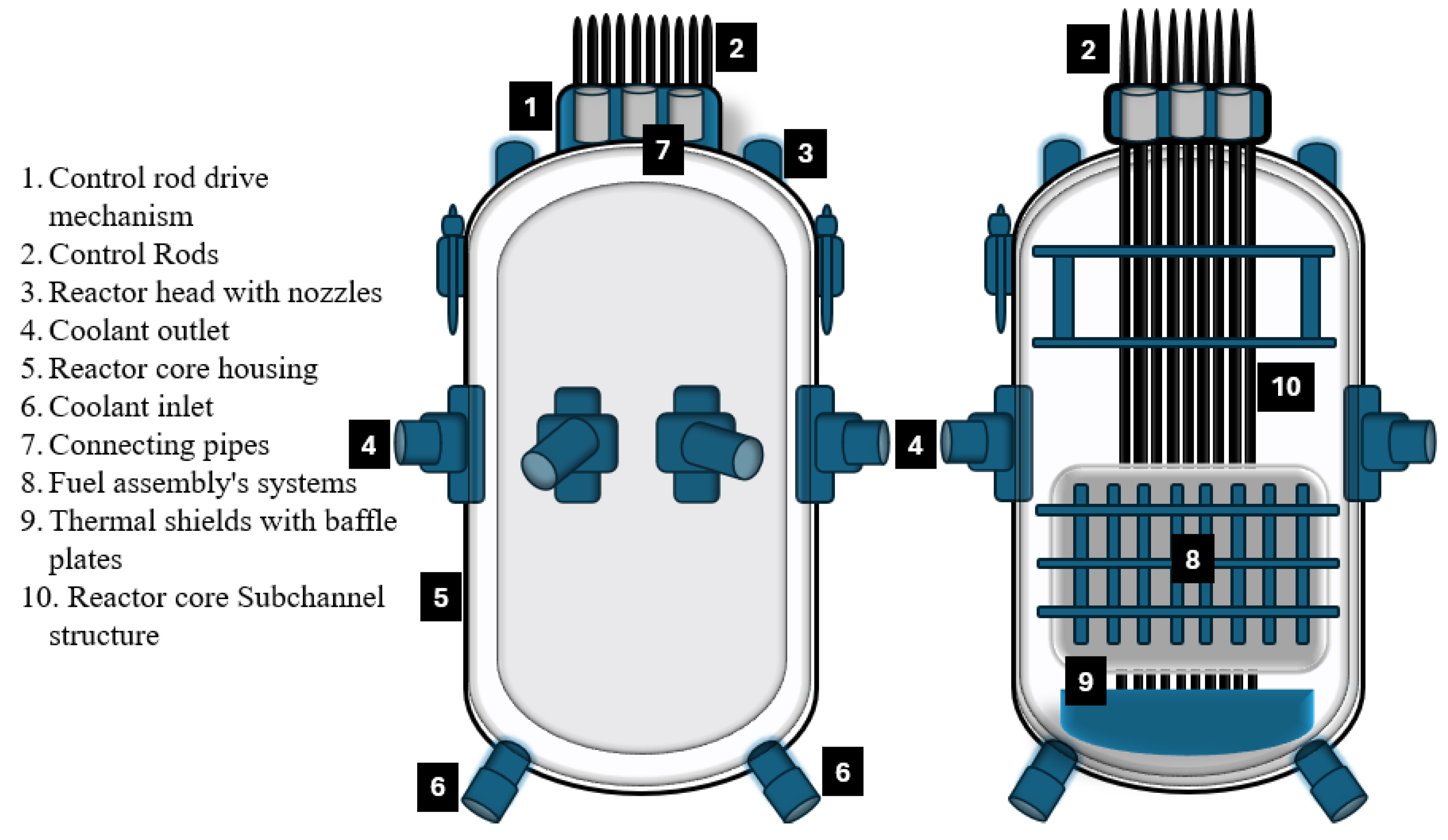
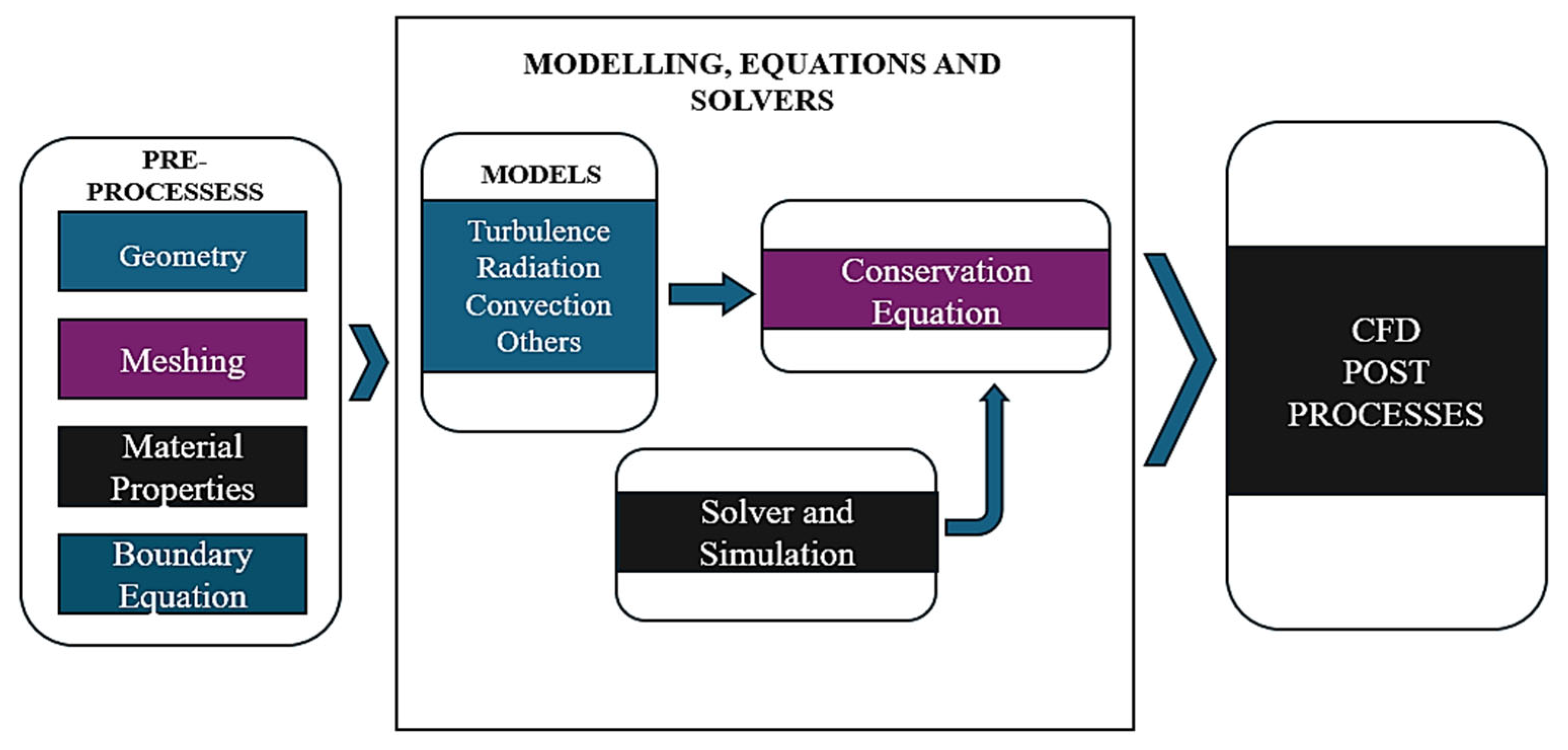
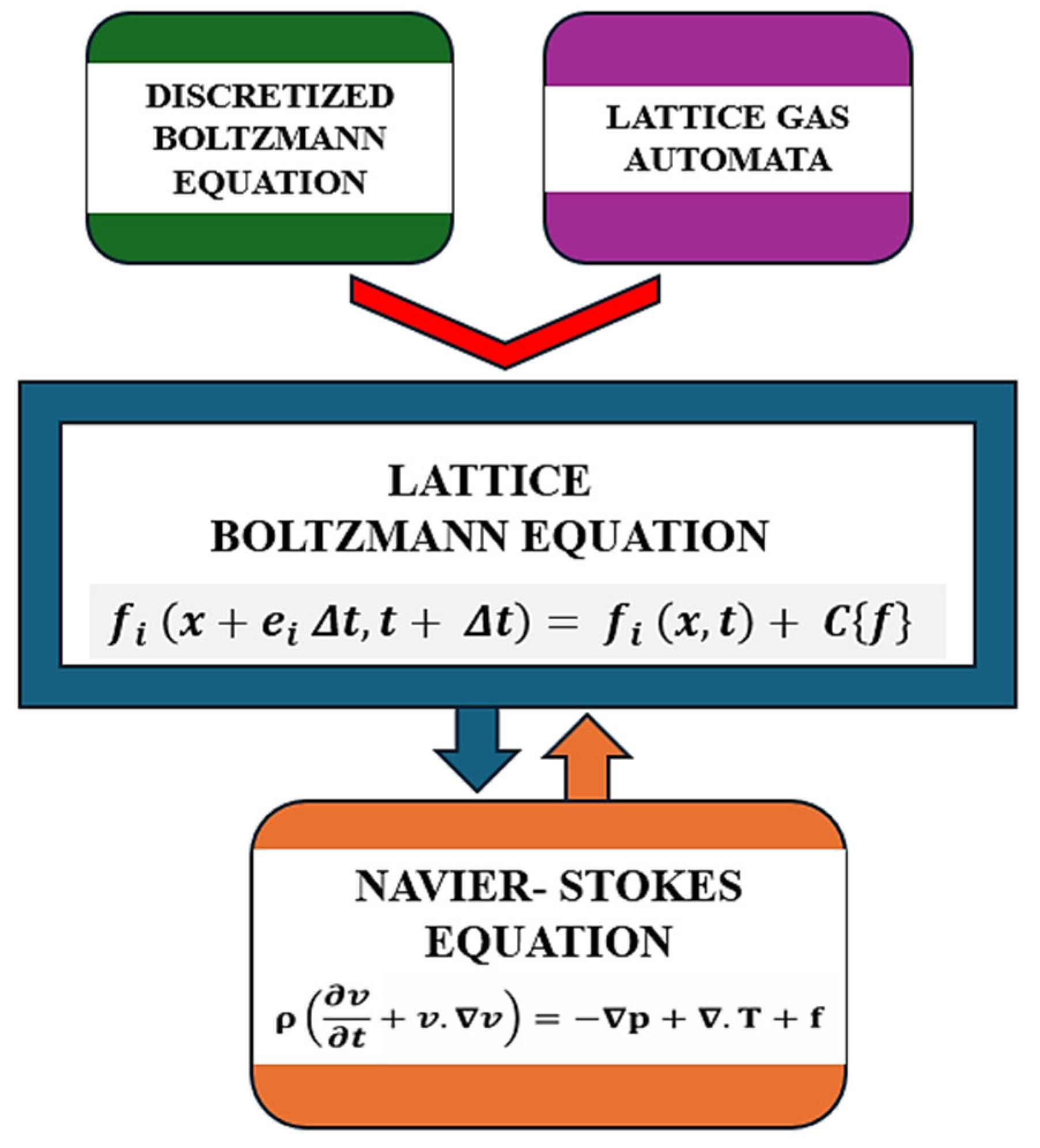
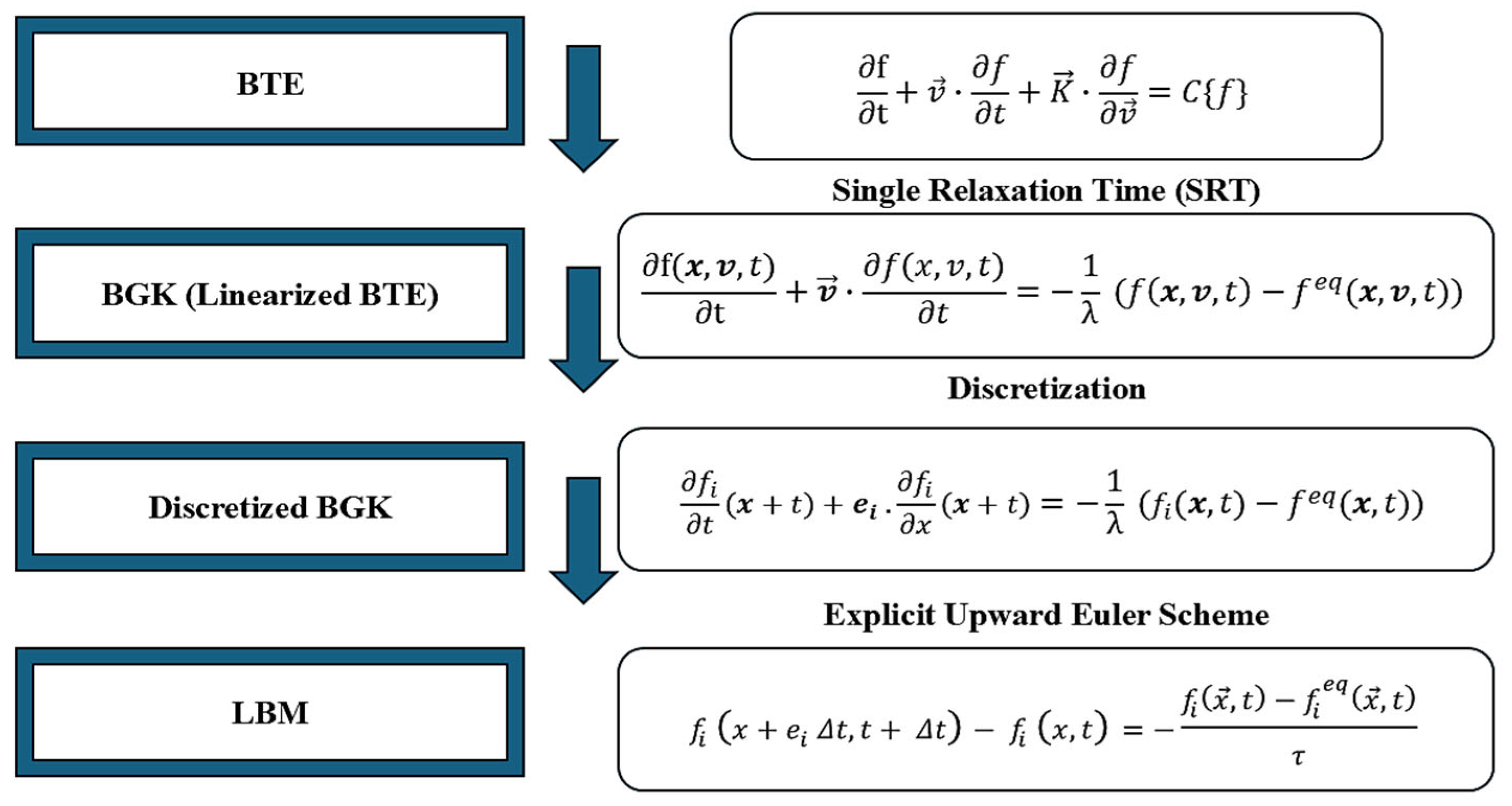

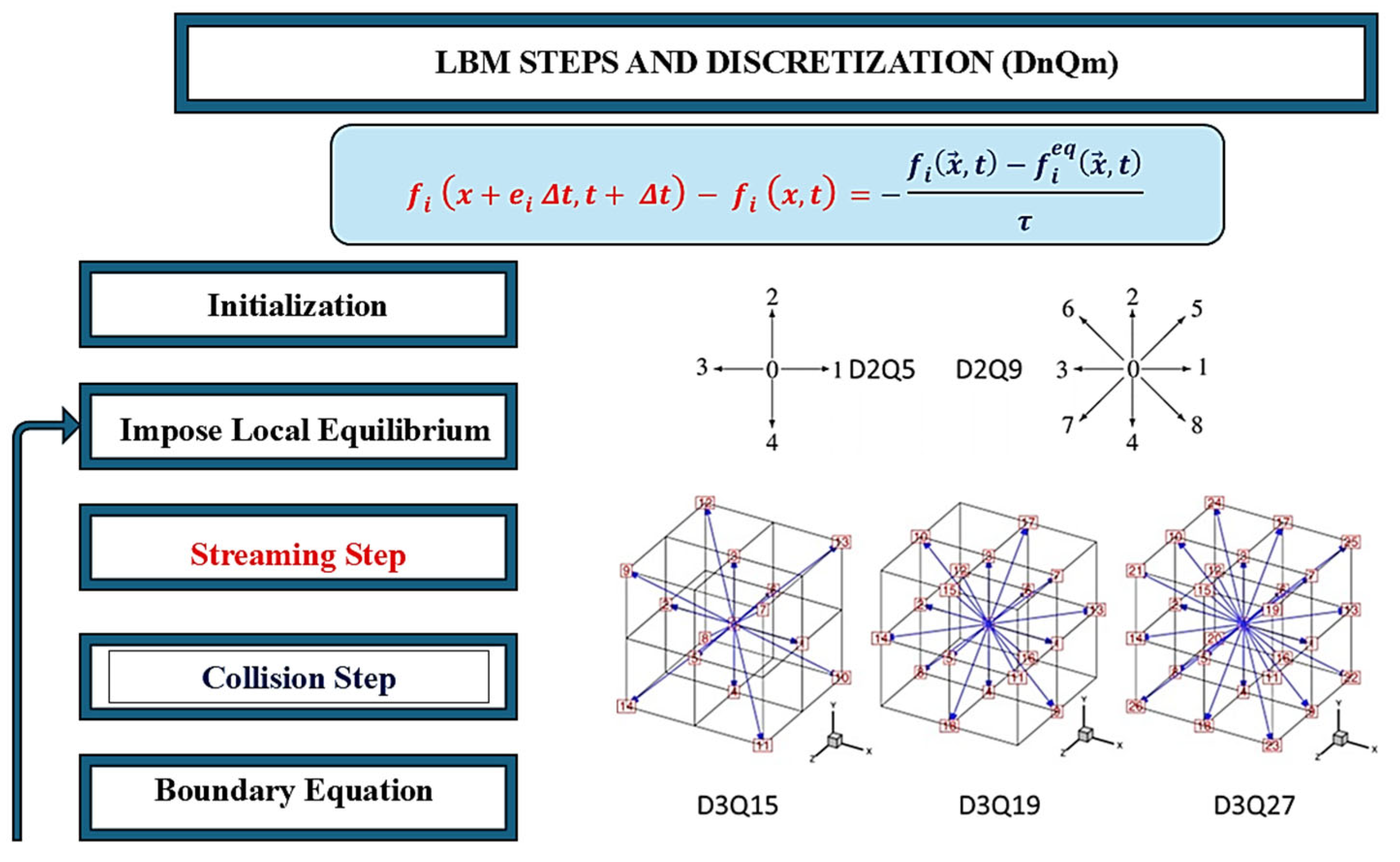
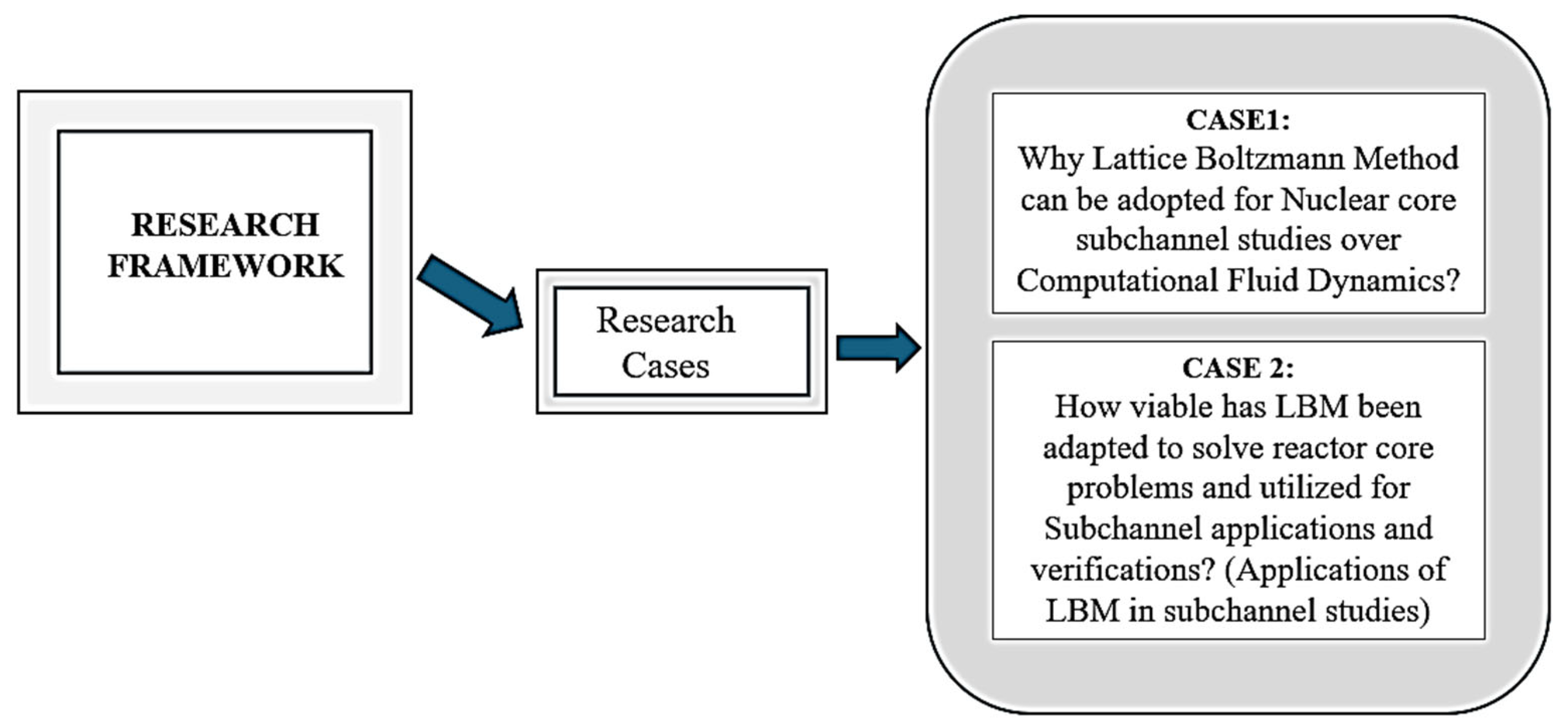
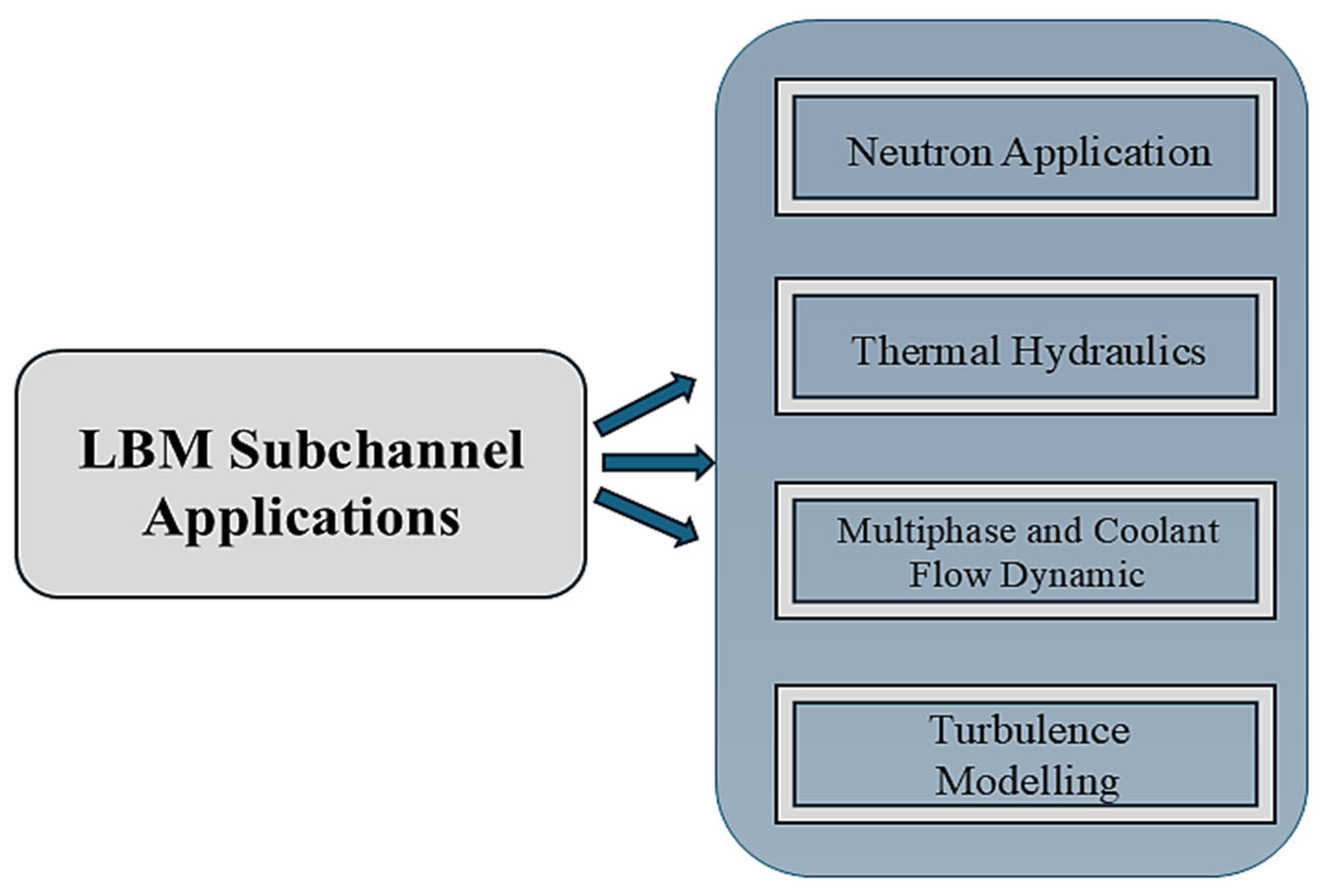
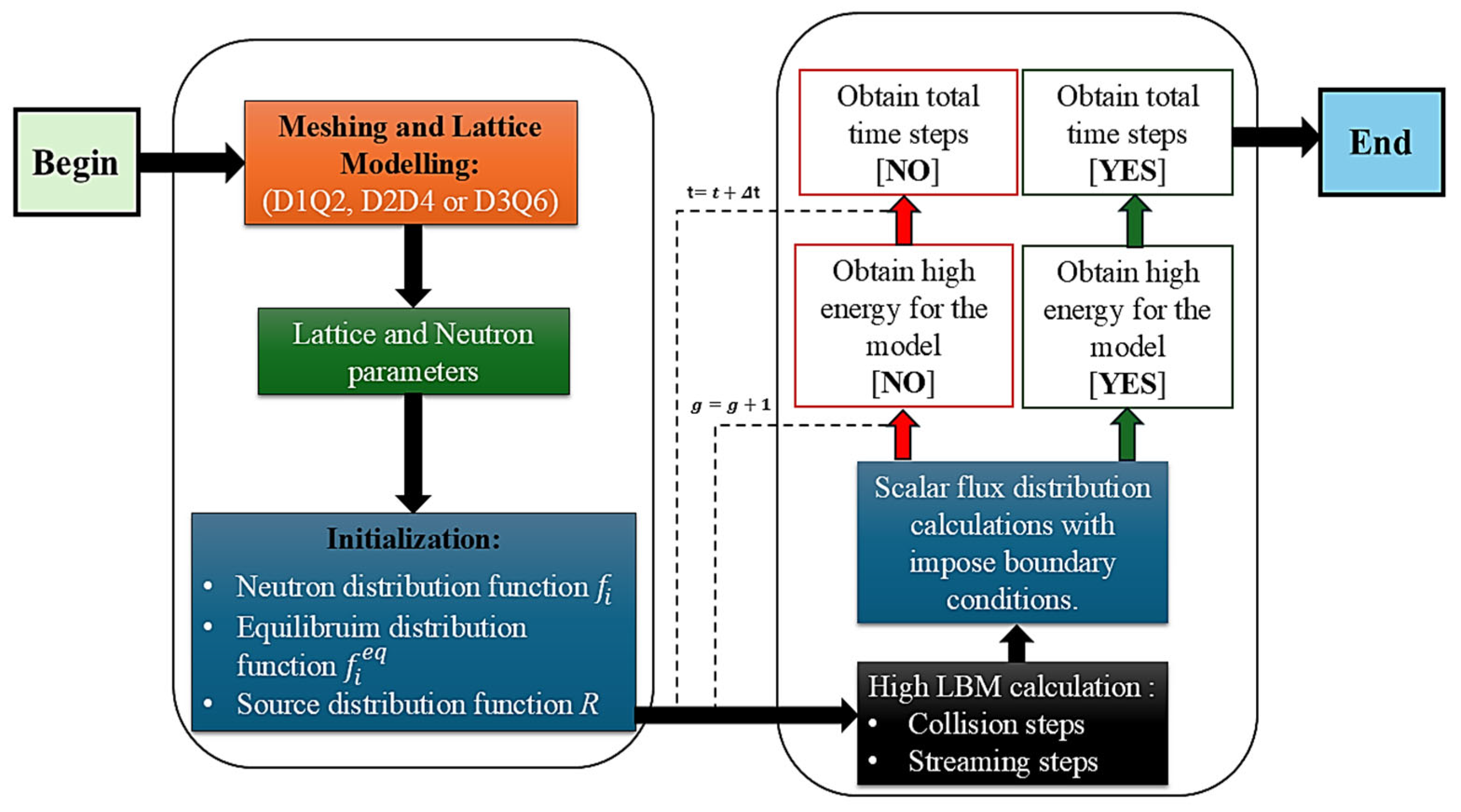

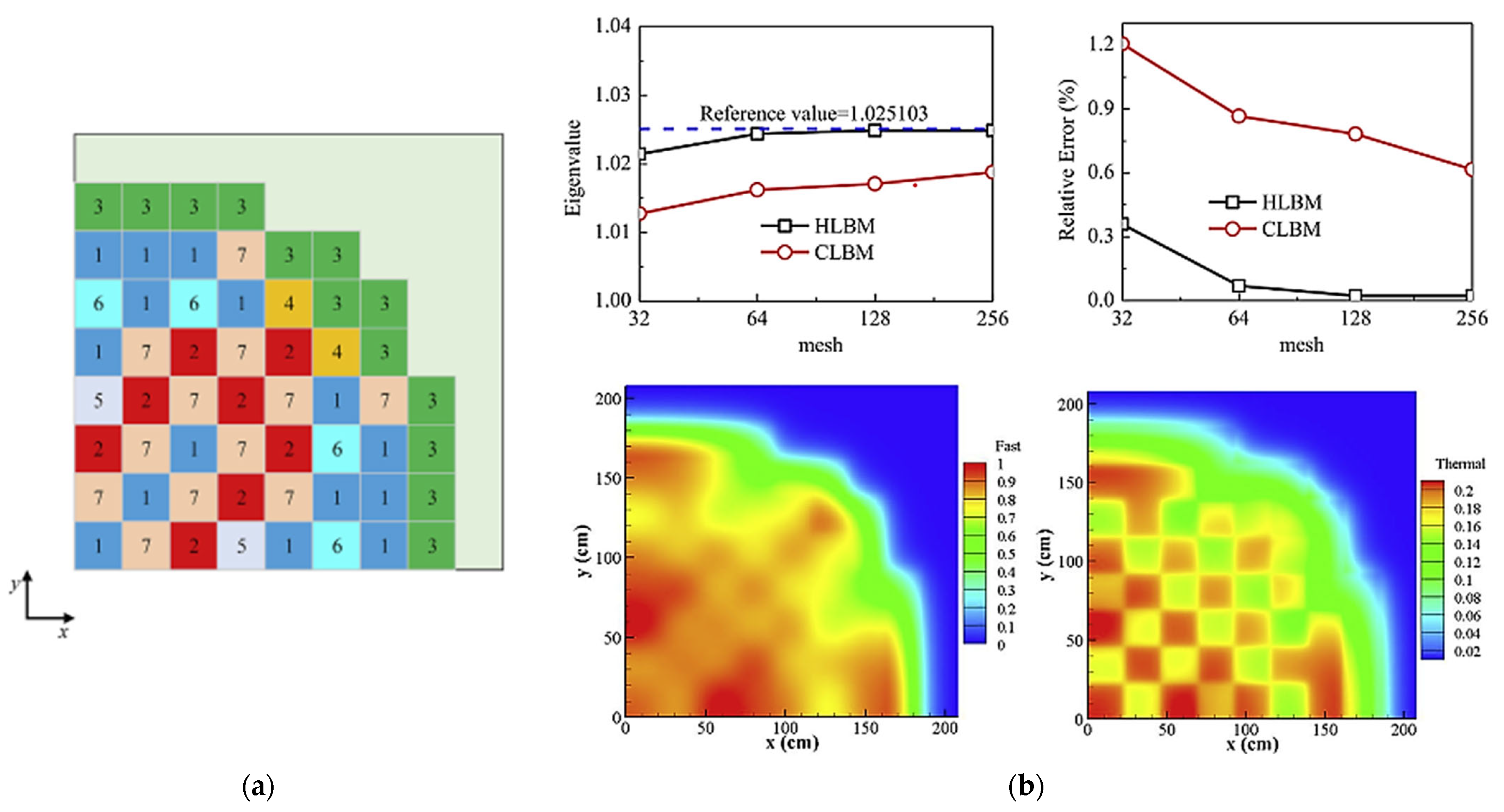
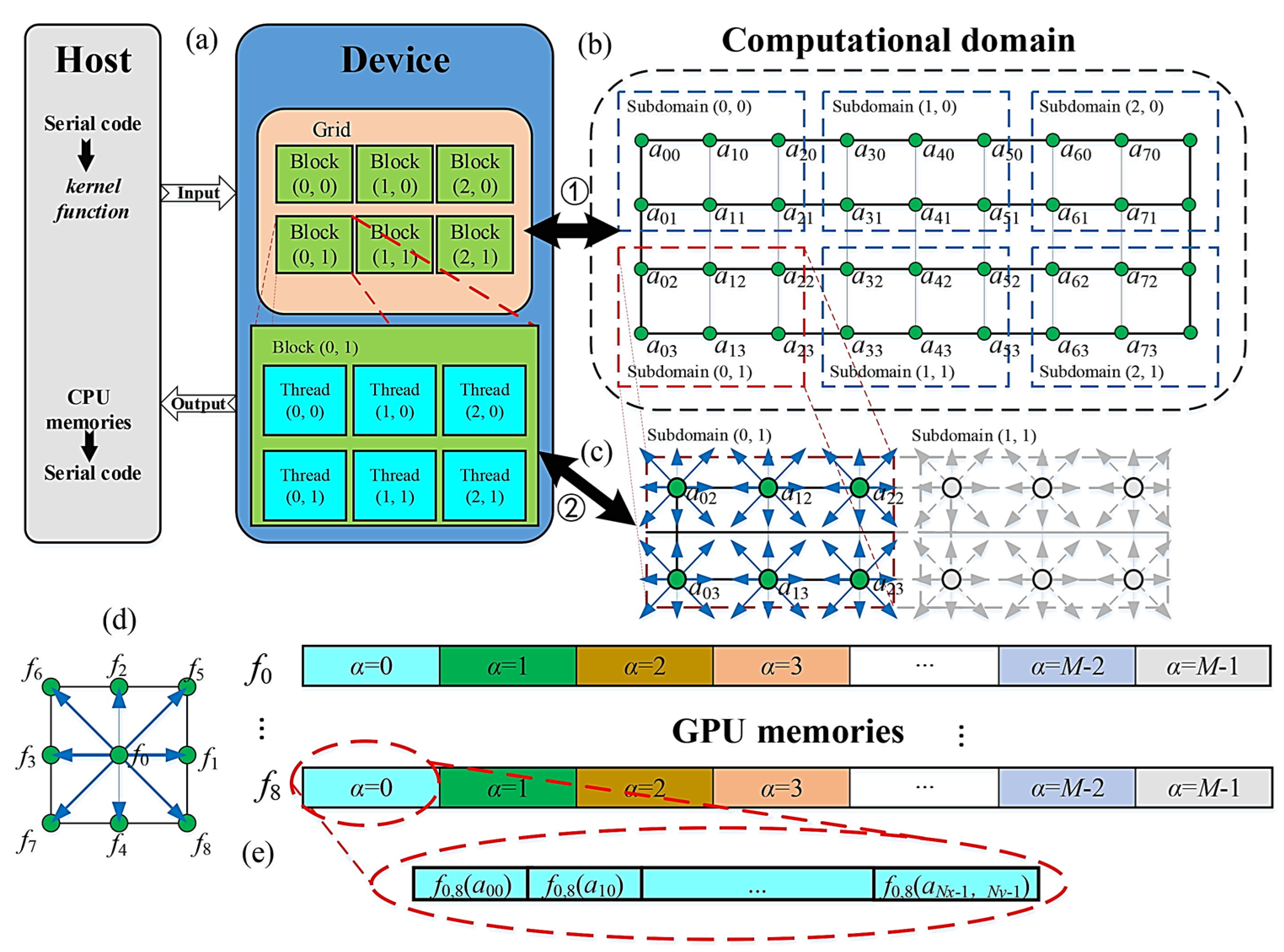
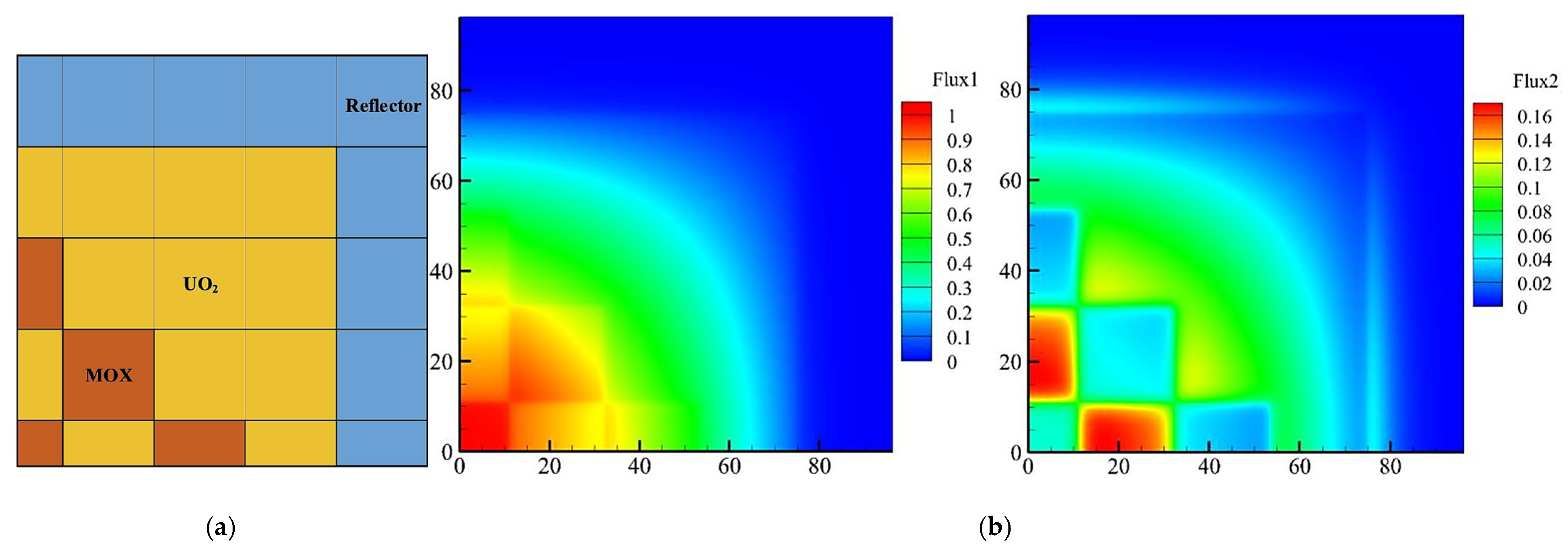

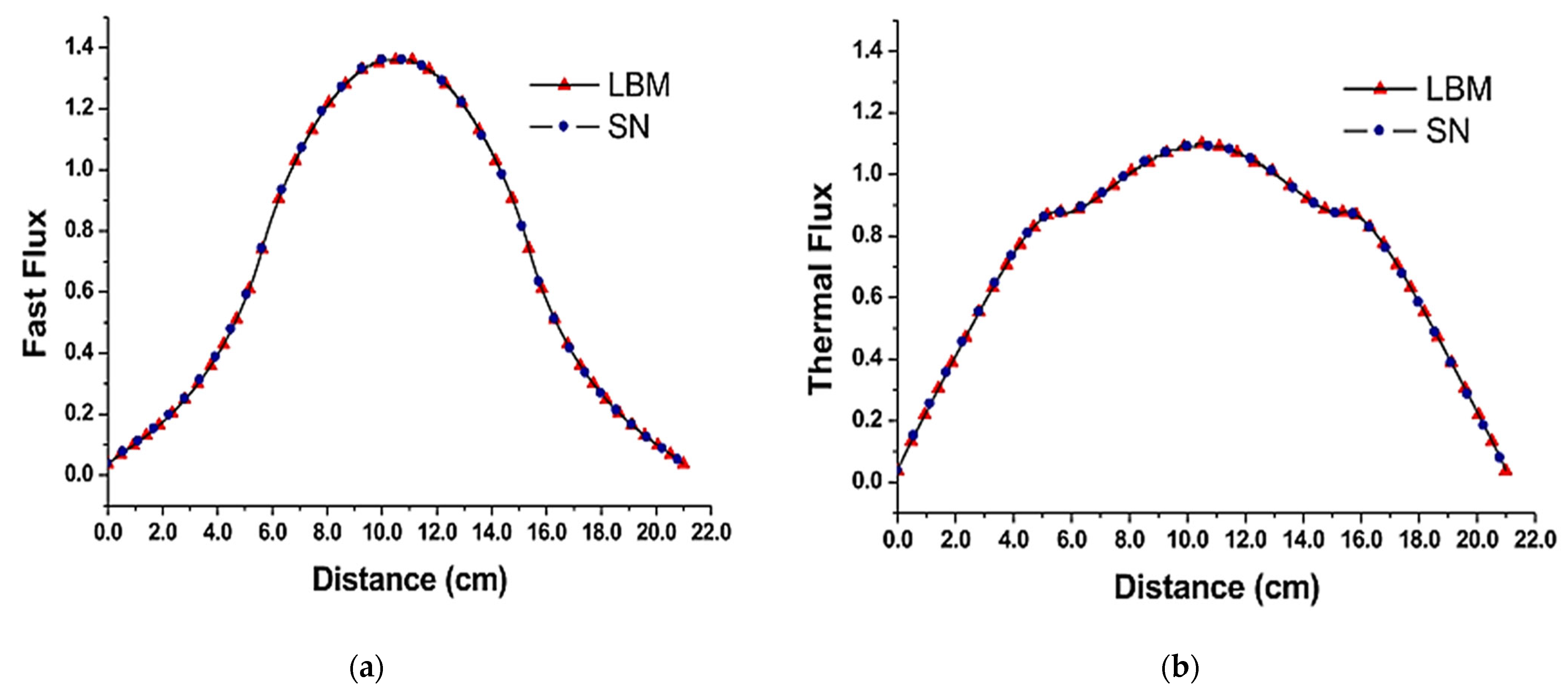
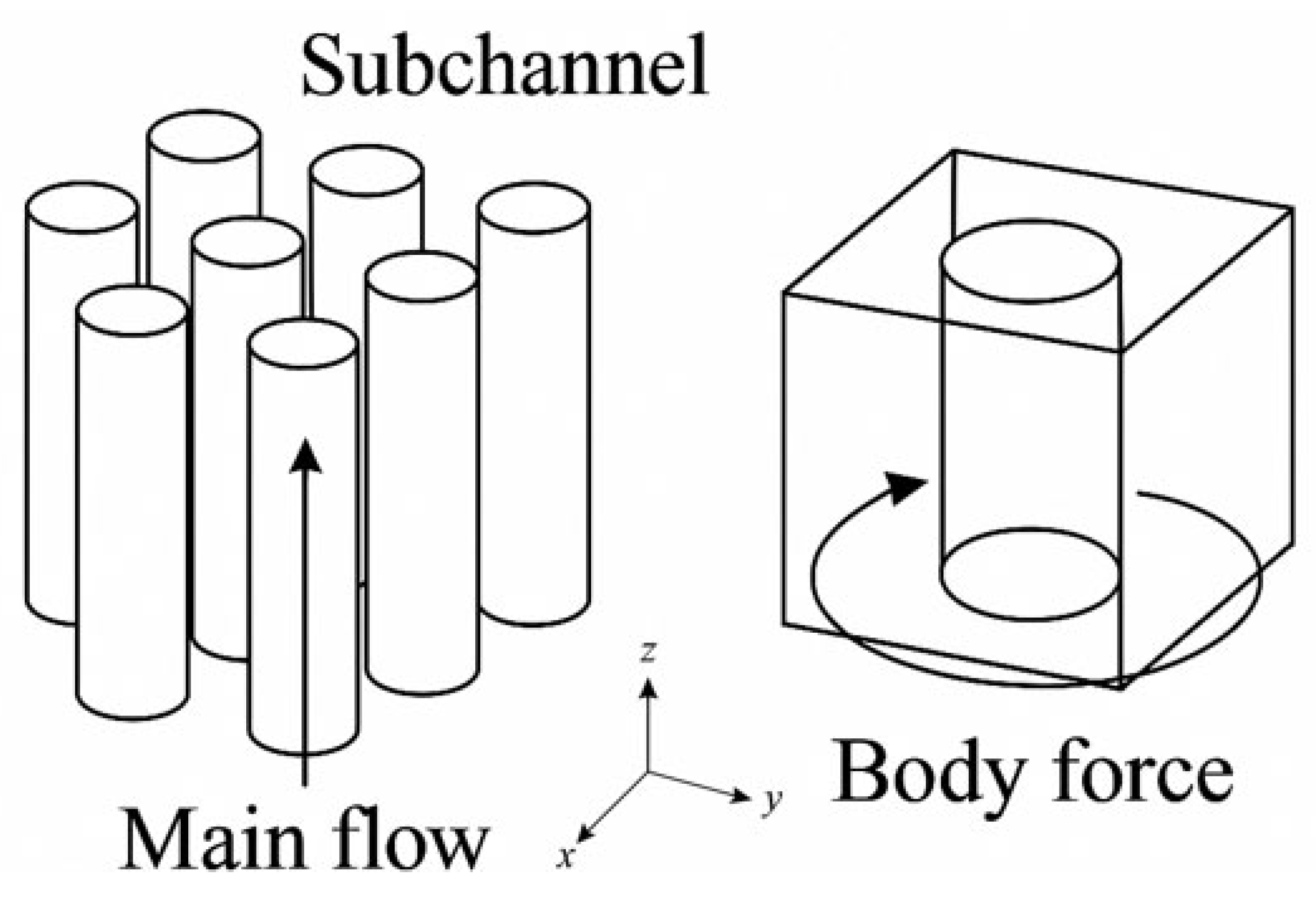


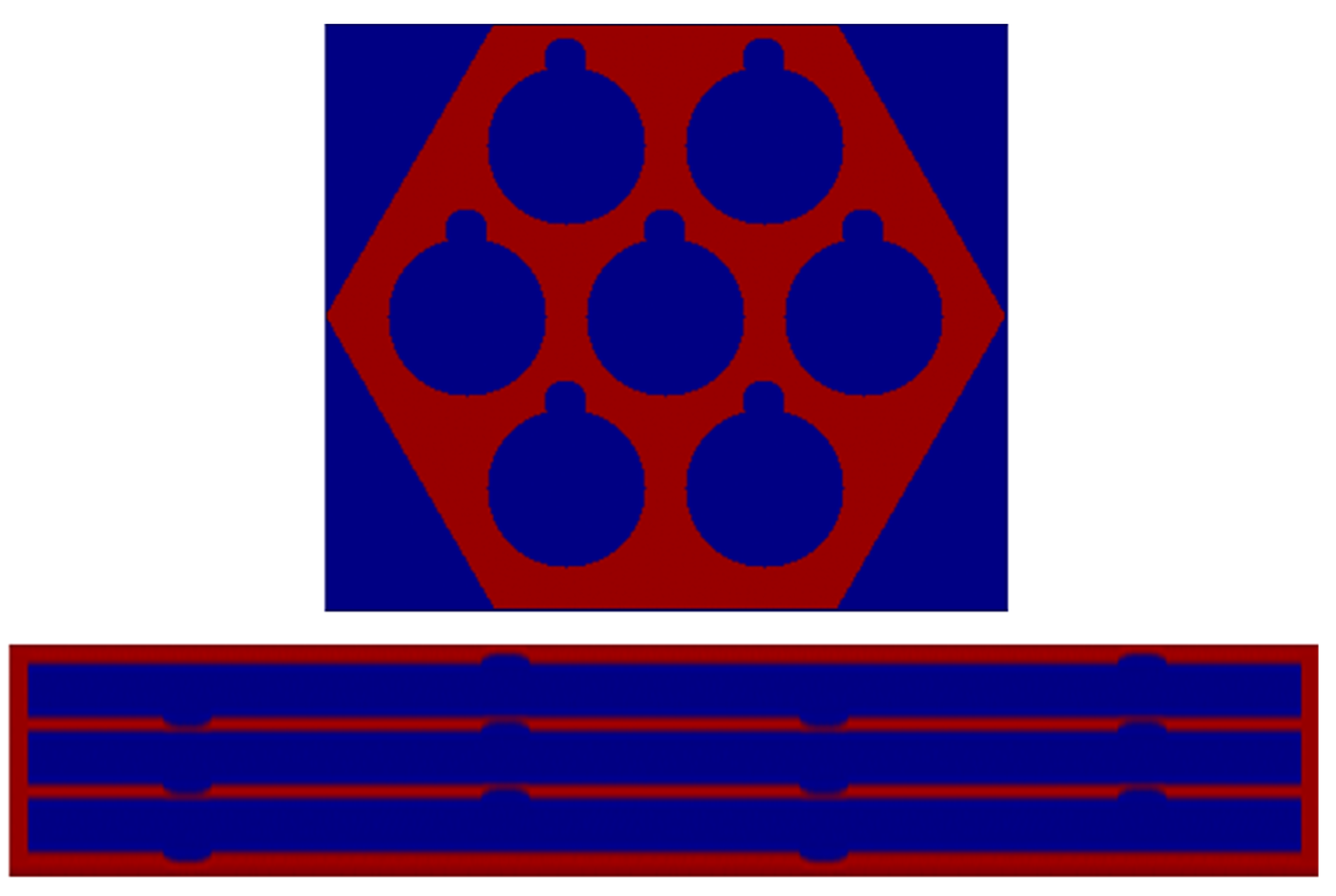
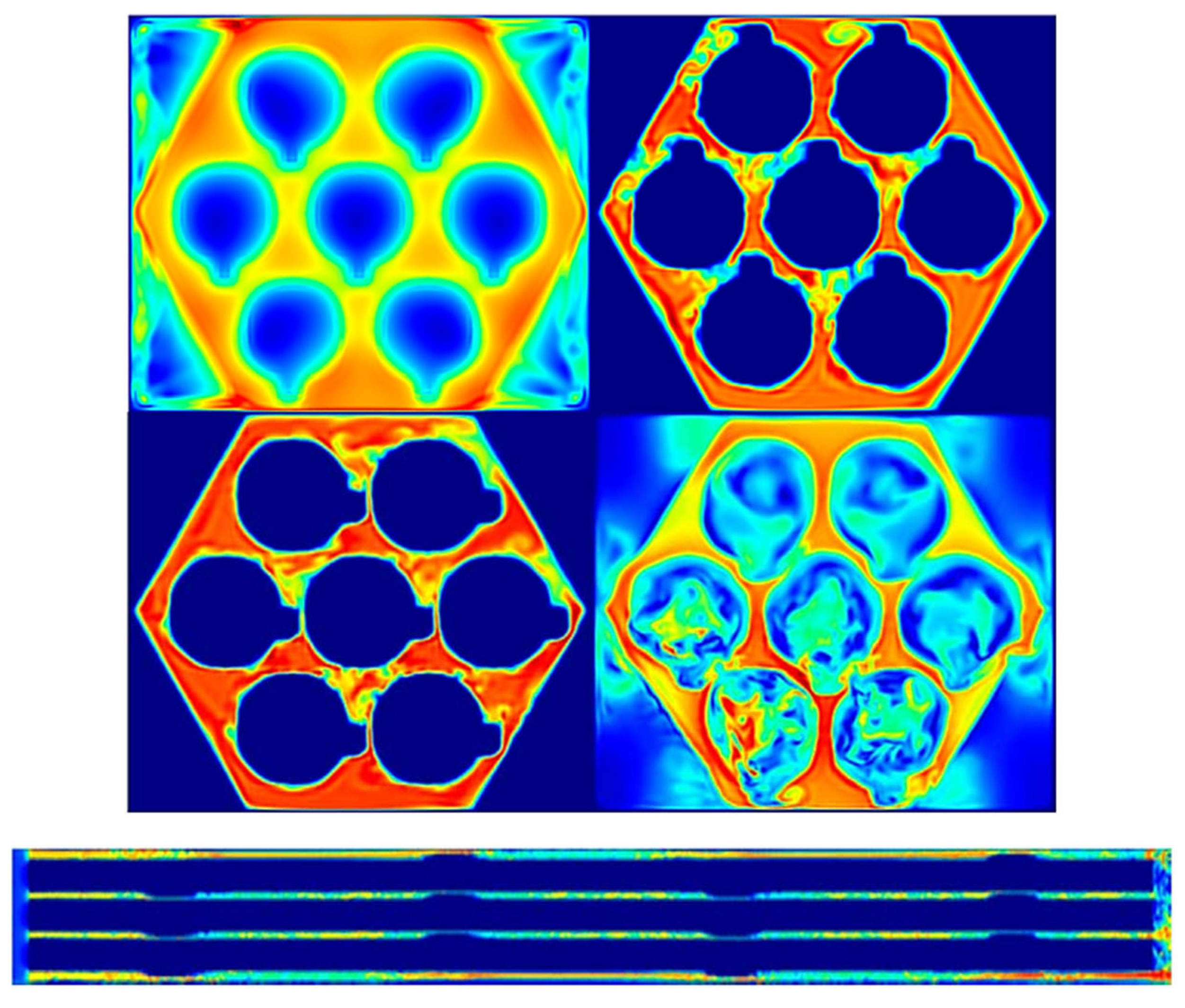
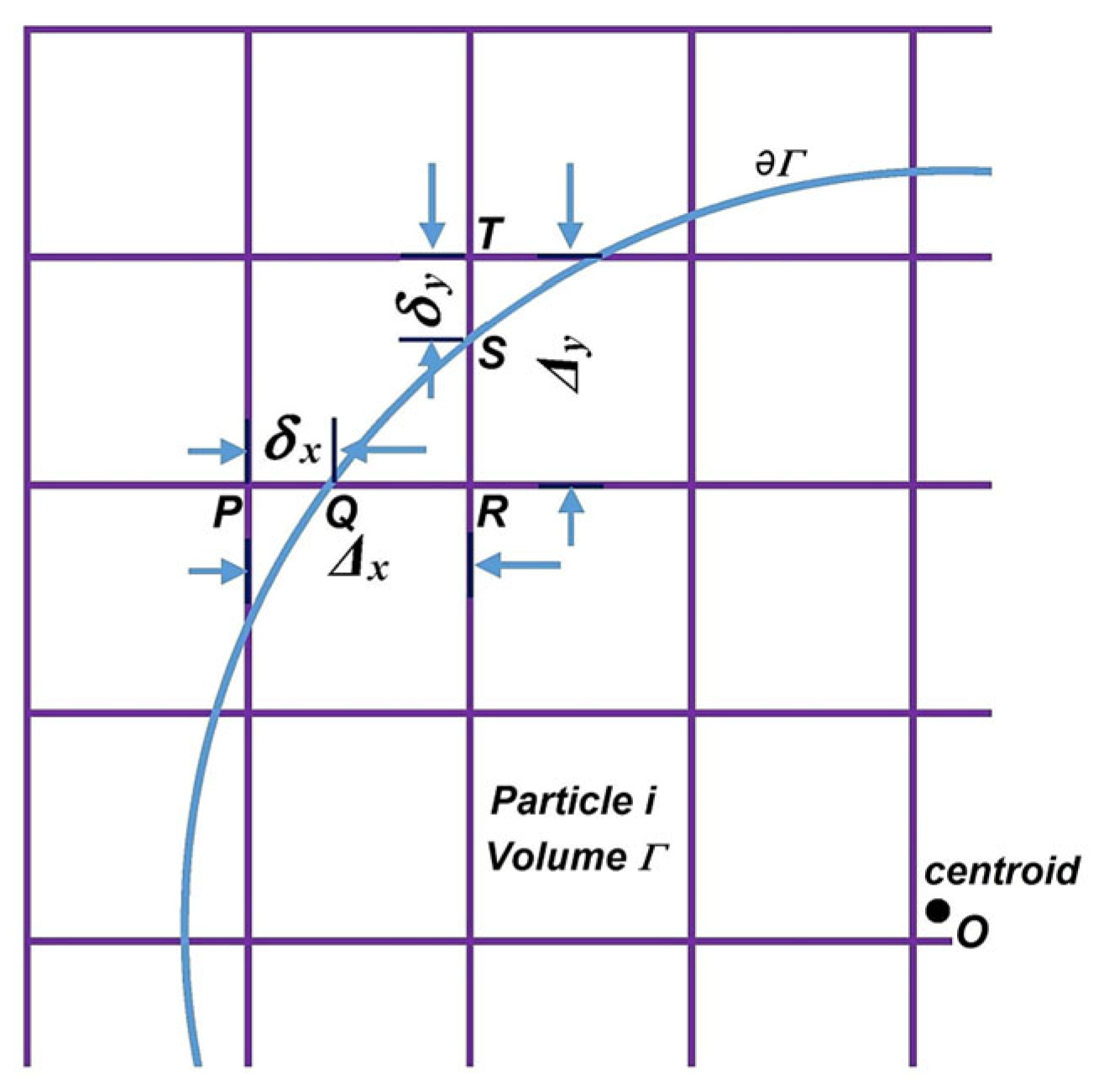
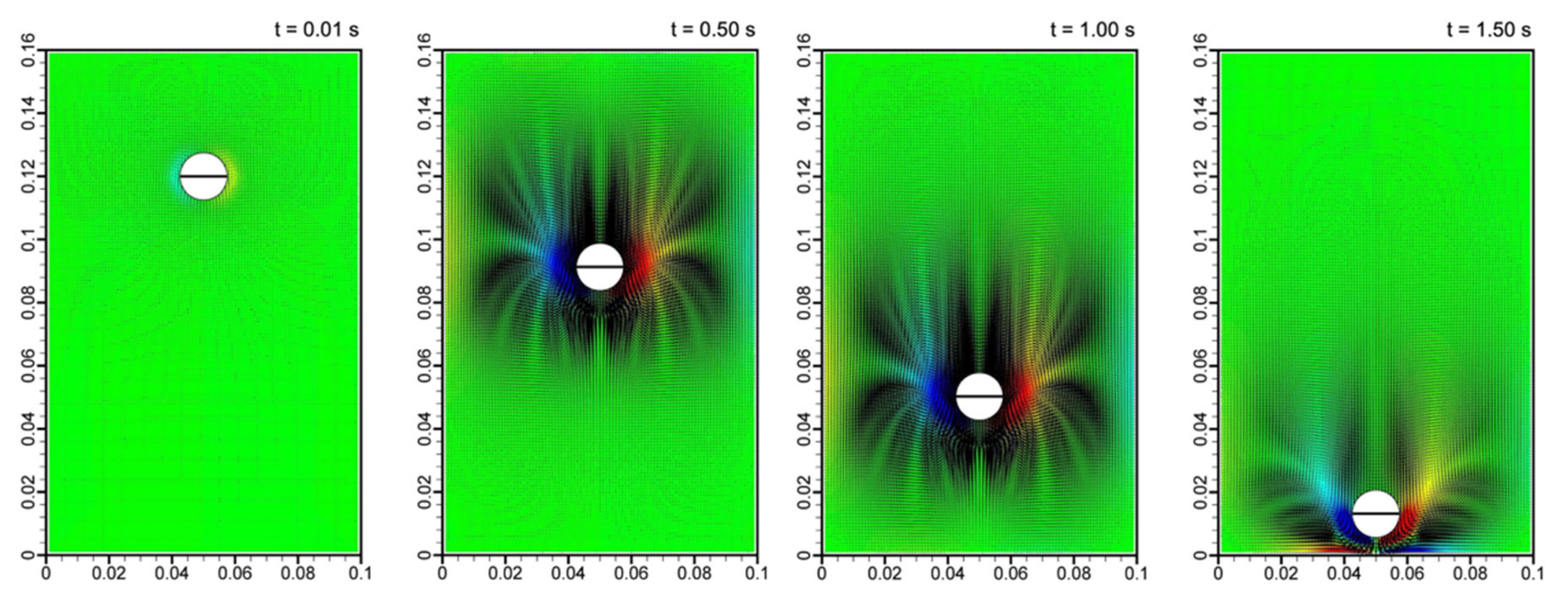
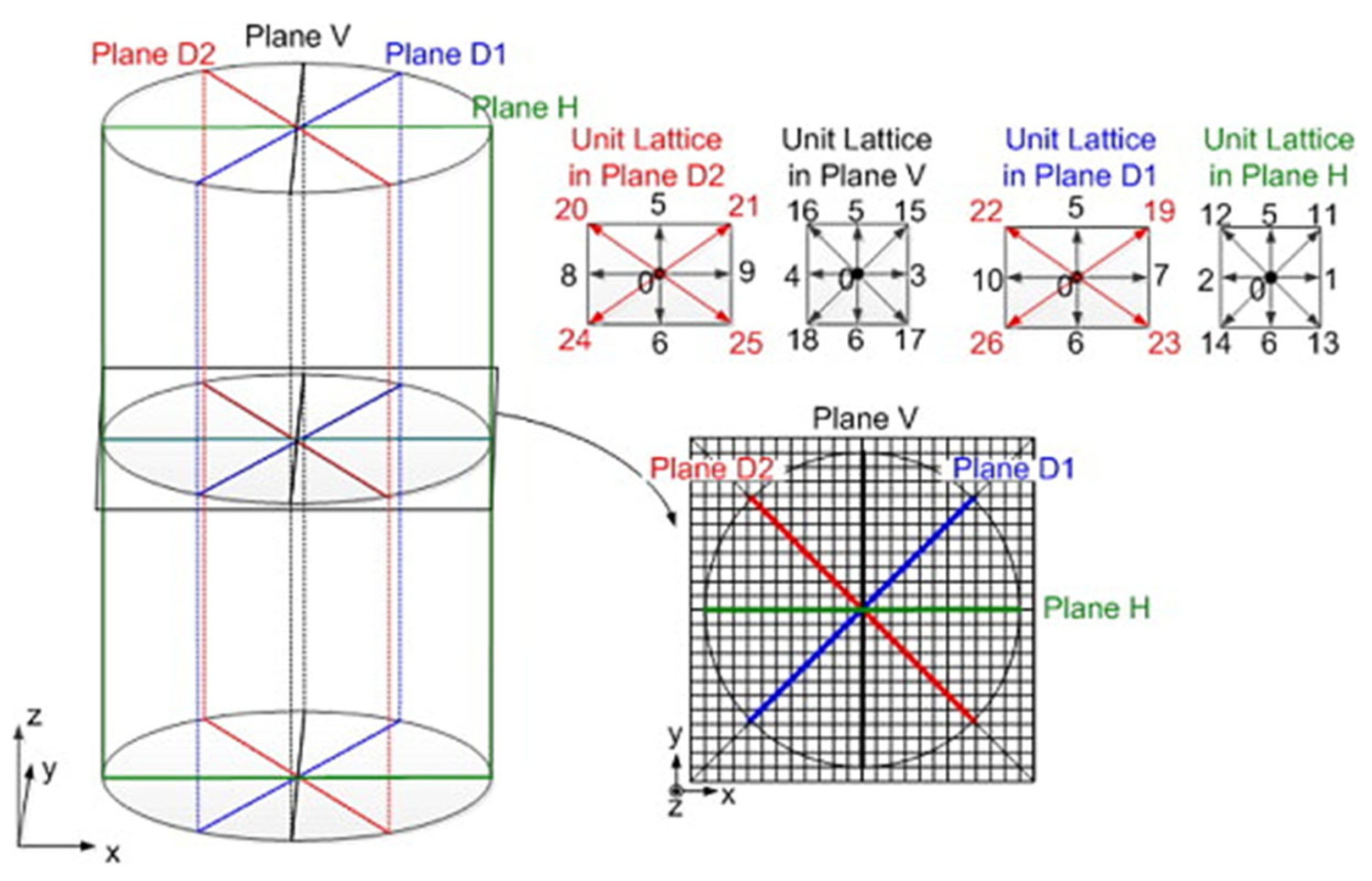
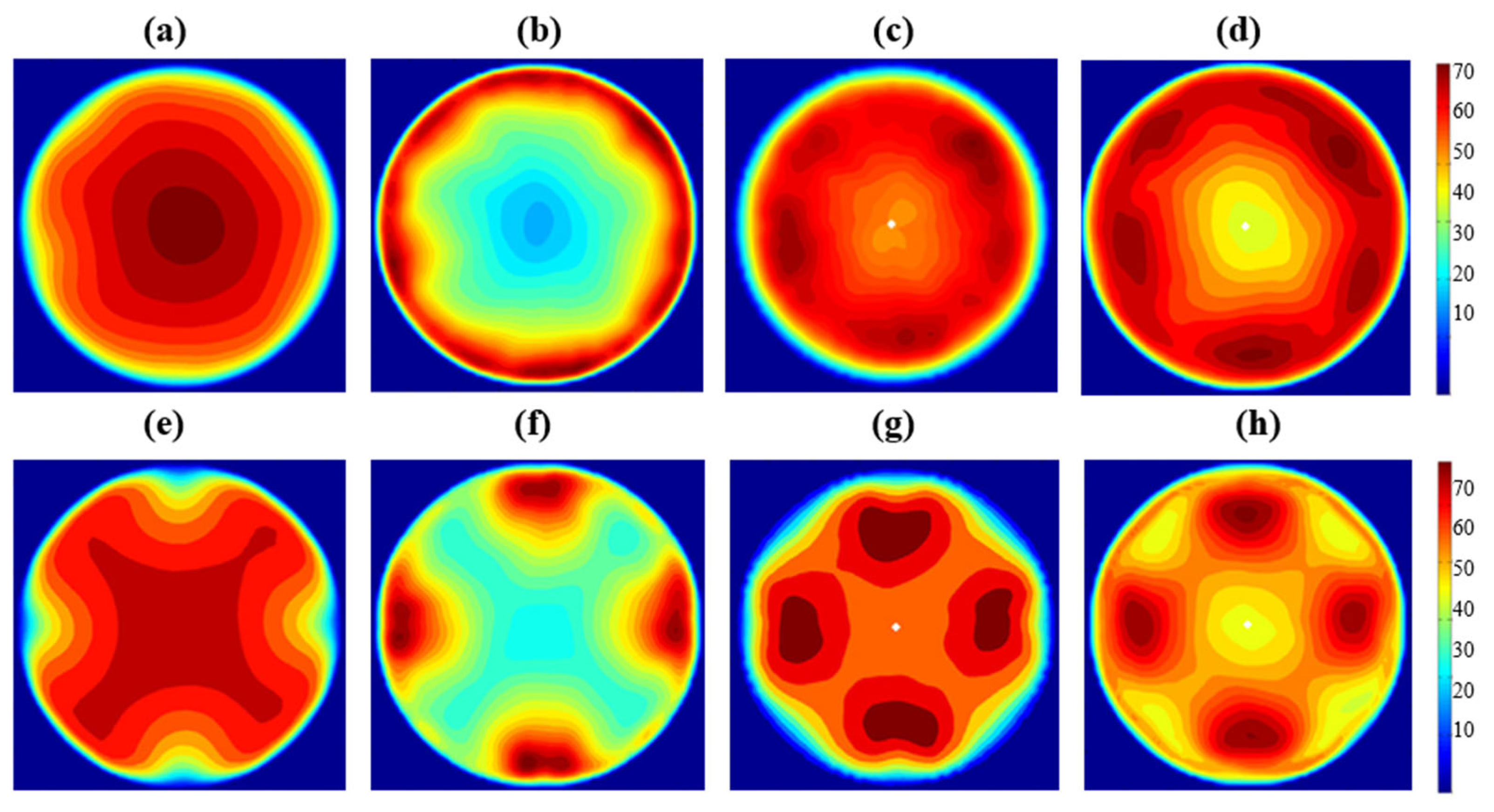

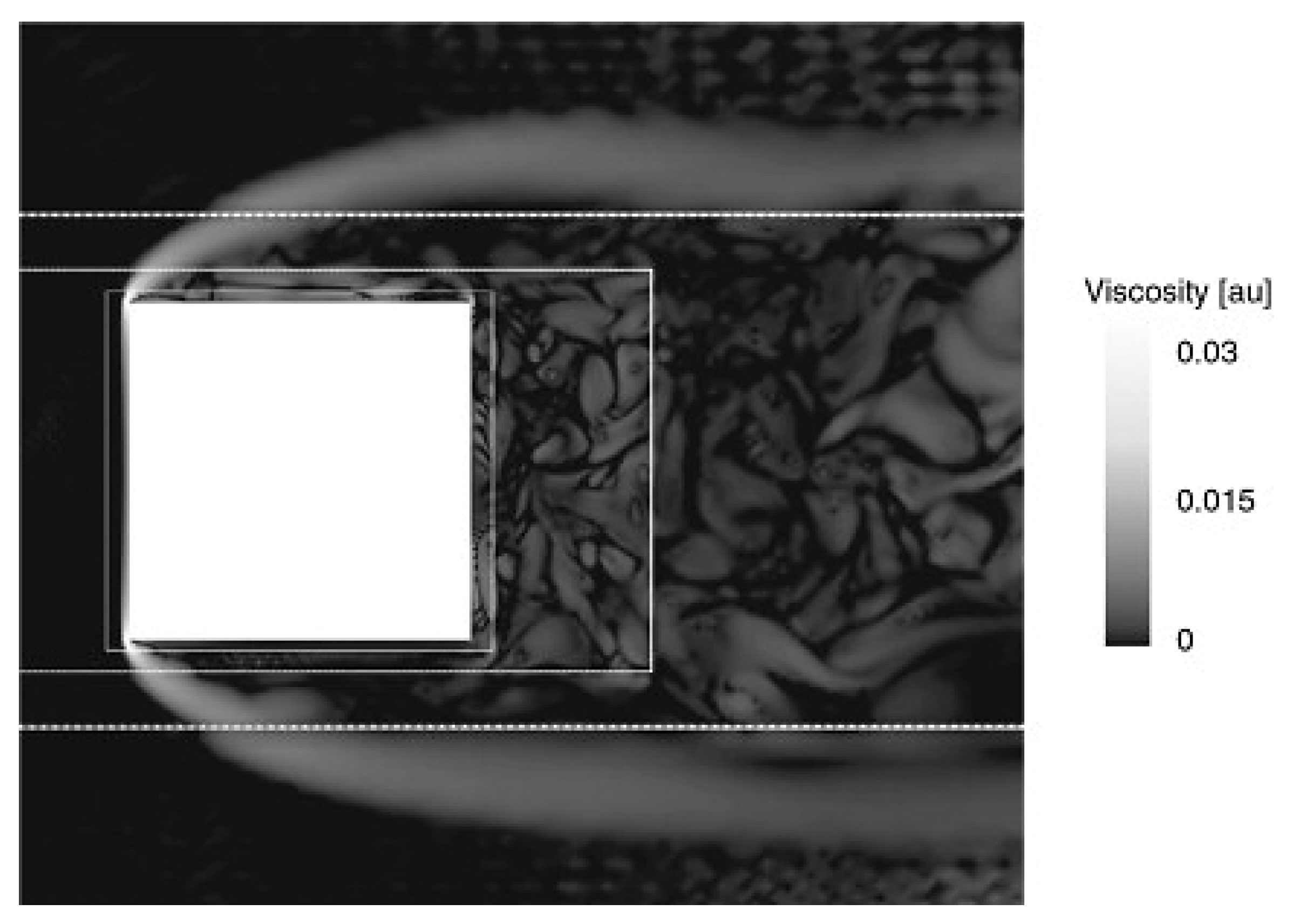
| Aspect | CFD | LBM |
|---|---|---|
| Governing Framework | Navier–Stokes Equations | Linearized Boltzmann Equation |
| Differential Equation | Partial second order | Partial first order |
| Convection | Non-linear; requires explicit discretization | Linear but convection via streaming process |
| Coordinates | Mesh system | Grid systems |
| Phenomena | Steady state with limited transient | Transient nature |
| Object | Macroscopic continuum-based | Pseudo particles based on probability distributions and collision operators. |
| Turbulence Modeling | Requires additional models like Large Eddy Simulations and Reynold-Average Navier–Stokes | Naturally incorporates turbulence through statistic mechanics with Large Eddy Simulations and Reynold-Average Navier–Stokes |
| Geometry | Based on CAD and meshing | Based on Lattice Nodes |
| Parallelization and Computations Cost | Moderately dependent on the numerical method used, but high cost due to complexity | High parallelization potential, enhancing computational efficiency but low cost for large-scale simulations |
| Validation and Benchmarking | Extensive validation against experimental data | Still developing (fewer benchmarks available) |
| Author | Problem | Lattice and Models | Validation and Insight |
|---|---|---|---|
| Wang et al. (2019) [51] | Diffusion of Neutrons (Transient) | D1Q2, D2Q4, D3Q6; Hybrid LBM (P1-LBM) | A numerical validation. A low-truncation-error LBM is less accurate than a high-order hybrid LBM. |
| Wang et al. (2019) [50] | Diffusion of Neutrons | D2Q4; GPU n-Dimensional Lattice Boltzmann Method (P1-LBM) | GPU benchmark validation. GPU parallelization is used for transient steady-state problems. |
| Wang et al. (2019) [51] | Transport of Neutrons | D1Q20, D2Q6; GPU Neutron Transport Lattice Boltzmann Method (Sn-LBM) | GPU benchmark validation. Spatial–angular parallelization for computational acceleration. |
| Agarwal et al. (2020) [49] | Homogeneous Neutron Transport in Thin Media | D1Q2, D1Q4, D1Q8, D1Q16, D1Q32; Neutron Transport-LBM | A numerical validation. A high-angular discretization used for criticality convergence in thin media (<5 mfp). |
| Author | Problem | Lattice and Models | Validation and Insight |
|---|---|---|---|
| Házi and Mayer (2005) [53] | VVER-440 PWR, reflux near fuel rods in array | D3Q27; BGK, LES (Smagorinsky) | Experimental validation: correlated flow characteristics with geometry changes; established LBM for turbulent CFD. |
| Mayer and Házi (2006) [54] | VVER-440 PWR, turbulent flux in triangular arrays | D3Q19, D3Q27; LES, BGK (Smagorinsky) | Experimental Validation: D3Q27 captured turbulent flux better; validated LBM’s turbulence capability. |
| Mayer et al. (2007) [62] | PWR, VVER-440: axial velocities and Reynolds stress | D3Q19, D3Q27; BGK, LES (Smagorinsky) | Analytical, experimental: normal stress validation highlighted lattice choice’s impact on modeling accuracy. |
| Park (2011) [58] | VHTR: flux in the lower plenum | D3Q13; MRT, WALE vs. LES (Smagorinsky) | Numerical (FVM) validation: suggested grid refinement near walls for high Re flows. |
| Fan et al. (2009) [55] and Kaufman et al. (2009) [56] | PWR: cooling chamber after LOCA | D3Q13; Hybrid MRT | Numerical (benchmark): observed cold plume formation during emergency cooling. |
| Li (2011) [63] | BWR, PWR coolant CRUD formation on wall interaction | D2Q9; BGK | Analytical (benchmark): simulated transport and deposition, validating LBM for surface interactions. |
| Park et al. (2012) [64] | Sedimentation post-LOCA | D2Q9; BGK | Experimental, numerical: evaluated sedimentation velocity and control devices like weirs. |
| Carrasco (2013) [65] | PWR: instability at high Reynolds numbers | D3Q19; BGK | Numerical (benchmark), analytical: developed multiscale procedures for instability modeling. |
| Tamura et al. (2017, 2018) [59,66] | FBR: impurity precipitation in cold traps | D3Q15; Lattice Refinement- LKS | Analytical and experimental: validated low-Reynold LR-LKS; optimized for computational efficiency in impurity precipitation. |
| Tiftikci and Kocar (2015) [57] | LMFBR: fuel rods with wire spacers | D3Q27; BGK, VLES (k-ε) | Experimental: improved tension factor and velocity profile accuracy with VLES. |
| Tiftikci and Kocar (2015) [57] | PWR, VVER-440: Heat transfer in triangular array | D3Q19, D3Q27; BGK, LES | Numerical (FVM), experimental: emphasized mesh refinement impact on flow and temperature distribution. |
| Wahba et al. (2017) [67] | LMFBR: flow circulation with low Prandtl numbers | D2Q9; BGK, Secondary Distribution | Numerical (LBM) validation: observed convection oscillations and their impact on system stability. |
| Tiftikçi and Kocar (2018) [68] | SFR: wire-wrapped fuel bundle | D3Q27; LES (Smagorinsky), WALE | Experimental, numerical: validated turbulent flow, showing strong agreement with friction factor data. |
| Gui et al. (2019) [60] | HTGR: pebble recirculation flow | D2Q9; BGK, IBM-DEM | Numerical validation: simulated helium reflux revealed intermittent flow patterns. |
| De Rosis and Coreixas (2020) [61] | Multiphysics flow simulations | D3Q19; Central Moments (CM-LBM) | Benchmark problem comparisons: focused on multiphysics flows, ensuring stability and accuracy in simulations, with new formulations for equilibrium and external forces. |
| Hudear and Shehab (2023) [69] | Staggered tube bundles (heat exchanger) | CFD Modeling; Realizable k-ε model | Compared with experimental data: increased heat transfer with reduced longitudinal pitch; validated simulation using CFD data. |
| Wang et al. (2023) [26] | Radiation–convection heat transfer | D2Q9 - | Numerical validation: developed LB framework for coupled radiation–convection. |
| Author | Problem | Lattice and Models | Validation and Insight |
|---|---|---|---|
| Filippova et al. (2001) [73] | General turbulence in complex systems (relevant for reactors) | D2Q9, D3Q15, others; general turbulence models (including RANS) | None specified: focuses on multiscale LBM schemes for turbulence modeling, essential for simulating reactor flows and other complex systems. |
| Weickert et al. (2010) [71] | Wall-bounded turbulent flows, reactor applications | General turbulence models (including RANS); WALE (Wall-Adapting Local Eddy) | Validation with LES models: explores WALE model integration with LBM to enhance simulation accuracy and efficiency in reactor-related turbulent flows. |
| Kang and Hassan (2013) [70] | Reactor applications, wall-bounded flows | D2Q9, D3Q19; Standard turbulence models | Limited validation: analyzes lattice models in LBM for reactor simulations, focusing on their performance in turbulence modeling and the challenges of wall-bounded flows. |
| Han et al. (2021) [72] | Built environment flows | D2Q9; Large-Eddy Simulation (LES) | Comparison with experimental data: investigates the role of wall function models in improving LES accuracy for built environment flows using LBM. |
| Reactor Scenarios | Setup | Measurement Technique and Data Collection | Insight |
|---|---|---|---|
| Single-phase flow (coolant flow in reactors) | A lab-scale cylindrical or rectangular reactor | Create a scaled-down reactor model using Particle Image Velocimeter (PIV) or Laser Doppler Anemometer for checking fluid flow field measurement. | For velocity profile, pressure drops, and flow patterns validations. Compare results with LBM predictions for velocity, flow patterns, and pressure drop. |
| Multiphase flow in reactor subchannel | A lab-scale reactor, multiphase flow purpose | Make a lab-scale multiphase flow reactor system with steam (gas) interacting with a liquid phase (coolant). Use a high-speed camera to capture coolant behavior, analyze distribution size, and compare to LBM predictions. | For capturing the phase change interaction and the mixing behavior of fuel and coolant in subchannels. |
| Thermal distribution or heat transfer phenomenon in subchannel | A lab-scale reactor with internal cooling or heating sources | Make a lab-scale Continuous Stirred-Tank Reactor (CSTR) with heating elements (infrared thermography or thermocouples) for mixing and thermal dynamics profiling. Validate LBM model predictions against experimental temperature profiles and distributions. | For monitoring and analyzing the thermal dynamics and mixing predictions in reactors. Predict mixing efficiency, temperature distribution, and rate of heat transfer. |
Disclaimer/Publisher’s Note: The statements, opinions and data contained in all publications are solely those of the individual author(s) and contributor(s) and not of MDPI and/or the editor(s). MDPI and/or the editor(s) disclaim responsibility for any injury to people or property resulting from any ideas, methods, instructions or products referred to in the content. |
© 2025 by the authors. Licensee MDPI, Basel, Switzerland. This article is an open access article distributed under the terms and conditions of the Creative Commons Attribution (CC BY) license (https://creativecommons.org/licenses/by/4.0/).
Share and Cite
Eugene, A.; Chung, P.-S. Subchannel Reactor Studies: Applications and Advances Using Lattice Boltzmann Method—Comprehensive Review Study. Fluids 2025, 10, 109. https://doi.org/10.3390/fluids10050109
Eugene A, Chung P-S. Subchannel Reactor Studies: Applications and Advances Using Lattice Boltzmann Method—Comprehensive Review Study. Fluids. 2025; 10(5):109. https://doi.org/10.3390/fluids10050109
Chicago/Turabian StyleEugene, Abutiatey, and Pil-Seung Chung. 2025. "Subchannel Reactor Studies: Applications and Advances Using Lattice Boltzmann Method—Comprehensive Review Study" Fluids 10, no. 5: 109. https://doi.org/10.3390/fluids10050109
APA StyleEugene, A., & Chung, P.-S. (2025). Subchannel Reactor Studies: Applications and Advances Using Lattice Boltzmann Method—Comprehensive Review Study. Fluids, 10(5), 109. https://doi.org/10.3390/fluids10050109







